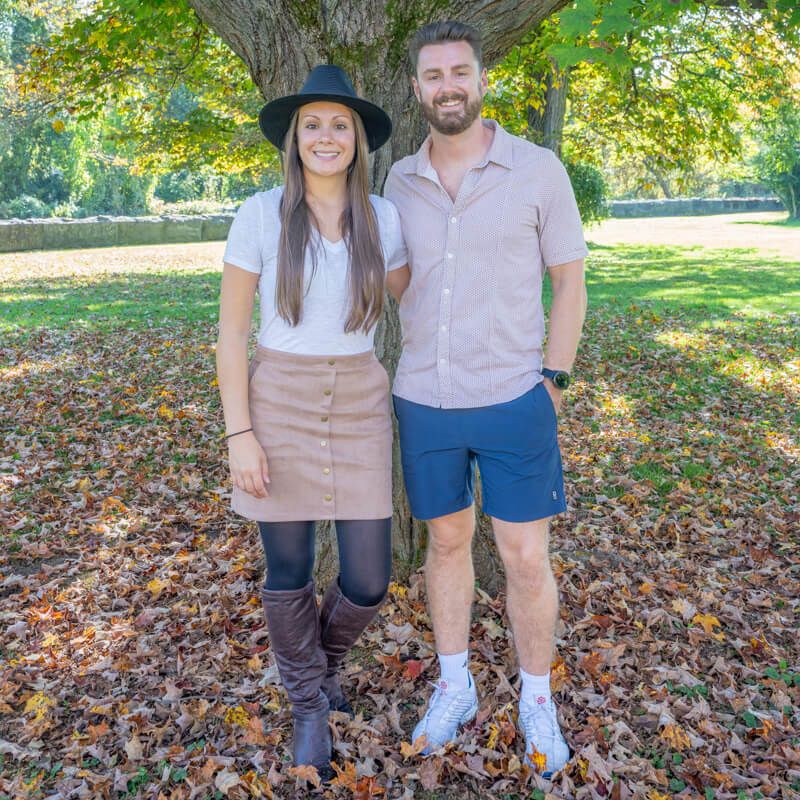Yellowstone is an extraordinary landscape that is quite literally overflowing with the world’s highest concentration of hydrothermal features. In this guide, we are going to walk you through the best places to visit and things to do in Yellowstone National Park.
Planning a vacation to Yellowstone for the first, second or even third time can be overwhelming because there are so many incredible sites to discover in America’s first national park.
We are here to help you plan your Yellowstone itinerary by showing you:
- Best places to visit in Yellowstone broken down by region
- Hiking and travel tips for your visit
- Best things to see in Yellowstone featuring highlights and lesser known activities
- Our personal Yellowstone photos
Without further ado, let’s explore the 50 best things to do in Yellowstone National Park!
Our Yellowstone National Park Experience
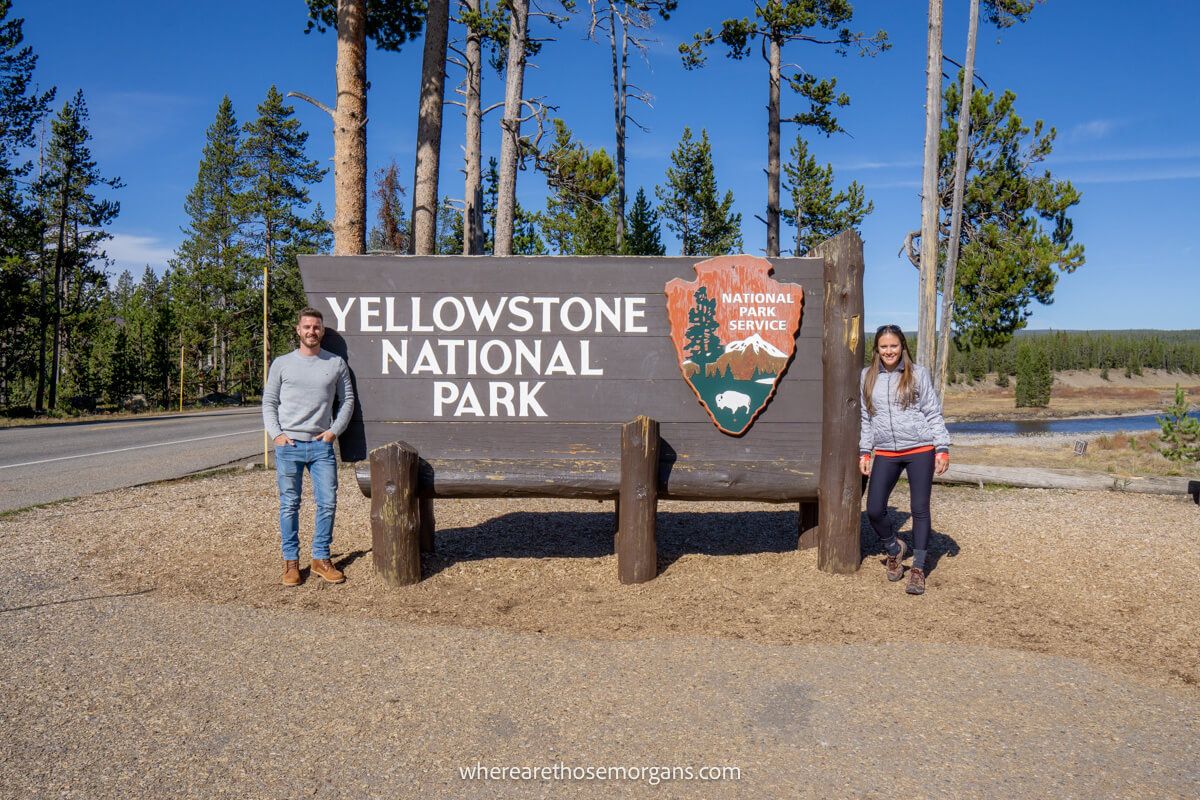
We first visited Yellowstone in October 2019 as part of a three month US road trip. But we loved the park so much, we visited again in April 2021 when we moved from New York City to Seattle.
Visiting Yellowstone National Park in different seasons is not only a magical, but it can be a completely different experience.
For example, when we visited Yellowstone in October, we learned the weather can be volatile when a last minute snow storm closed the park for a day.
When we visited Yellowstone in April, many of the hiking trails were closed, but we had most of the park to ourselves and the wildlife were extremely active.
In this guide, we’re not only going to show you the best things to do and places to visit, but we also give you our best Yellowstone tips for making the most of your trip.
Yellowstone is a true bucket list USA vacation spot and we want you to leave feeling like you are prepared to visit America’s oldest national park.
So between our two personal visits to Yellowstone and the numerous days we spent creating this extensive resource, we hope to give you the best things to do in Yellowstone National Park guide you can find!
Interesting Facts About Yellowstone
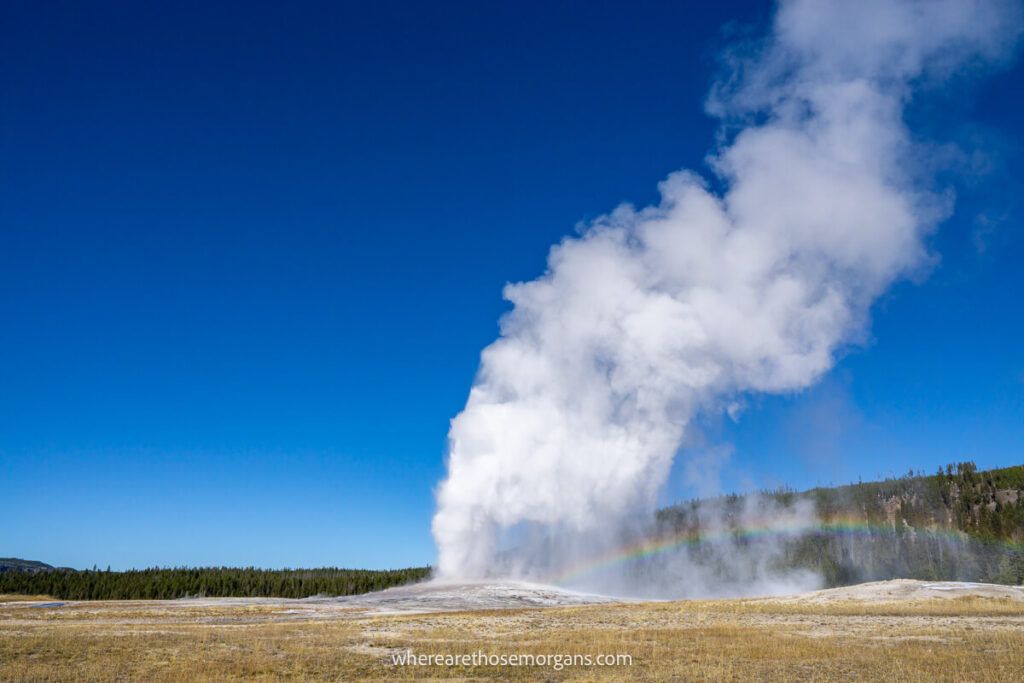
Before diving right into the best Yellowstone highlights, there are a few important things to know about this extremely popular national park.
When compared by land mass, Yellowstone is the second largest national park in the lower 48 states encompassing 3,472 square miles or 2,221,766 acres.
In 2021, the park experienced 4.86 million visits making Yellowstone one of the most visited US National Parks with July being the busiest month. However, 2022 visitation was slightly decreased due to the June floods.
The Yellowstone caldera is considered to be a supervolcano because one of the world’s largest active volcanos lies beneath the park. The NPS often refers to Yellowstone as a restless giant and it will erupt again in the future.
This supervolcano is why Yellowstone is home to more than 10,000 hydrothermal features. Half of the world’s hydrothermal features can be found in the national park.
The five types of hydrothermal features you can expect to see in Yellowstone are geysers, hot springs, mudpots, travertine terraces and fumaroles.
Thermophiles are heat loving organisms (40-80°F) and Yellowstone is home to numerous hyperthermophiles who prefer temperatures above 80°F.
While too small for the naked eye, these thermophiles showcase the vibrant colors you will see in the hot springs and streams found throughout the park.
Not often known for it’s hiking like Zion National Park, Yellowstone is home to over 1,000 miles of hiking trails and will cover the best hikes throughout this guide.
Interested in the national parks? Don’t miss our popular guide featuring the best USA National Parks.
6 Yellowstone National Park Regions
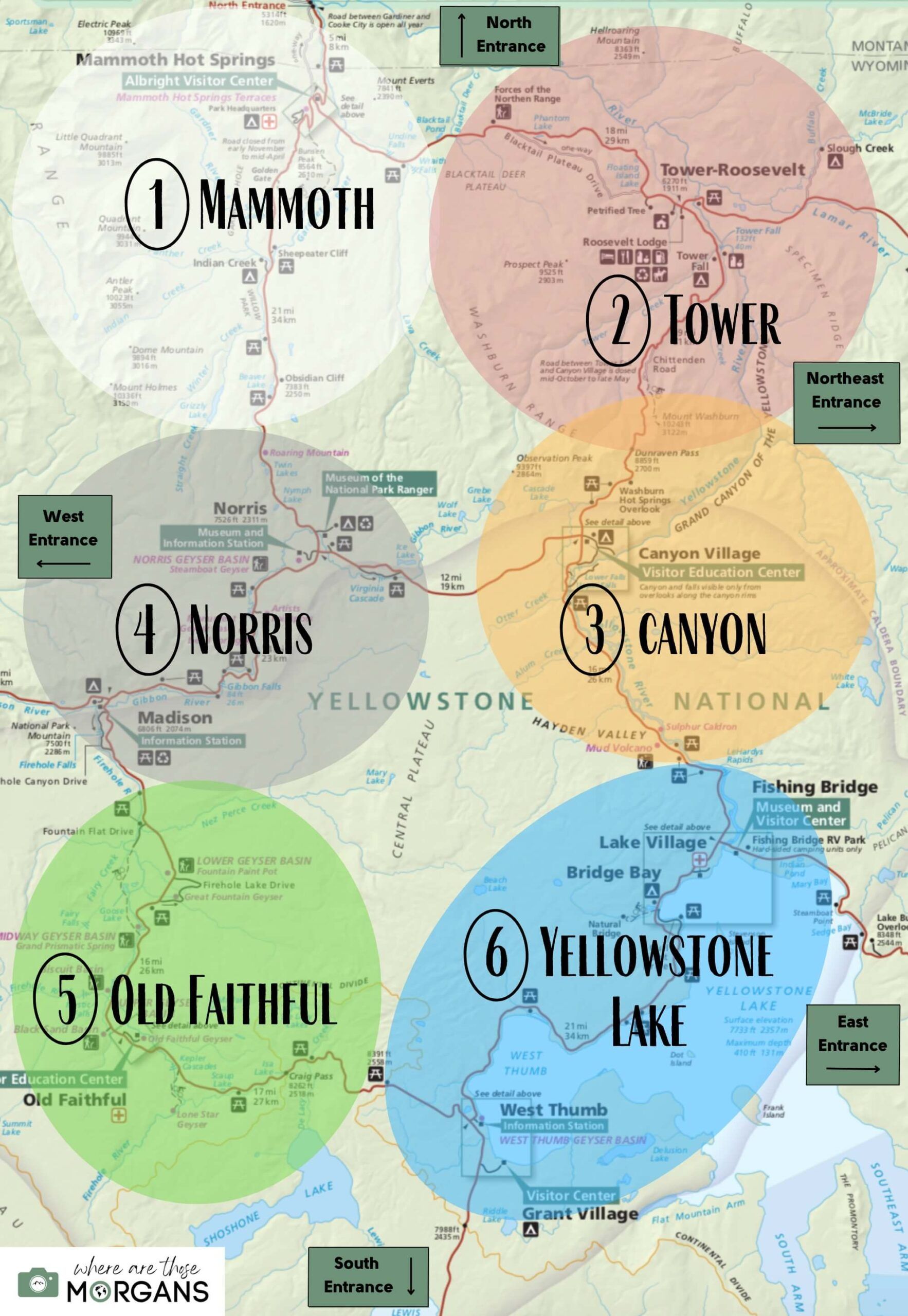
In order to make this an easy to understand Yellowstone guide, we have divided the park into 6 regions. You should think of these regions as the 6 main places you need to visit in Yellowstone.
- Mammoth
- Tower
- Canyon
- Norris
- Old Faithful
- Yellowstone Lake
Best Places To Visit In Yellowstone
Here is a brief description of each individual region in Yellowstone so you can get a better understanding of where you want to visit:
- Mammoth – This is the most northern region of the park featuring Mammoth Hot Springs and historic Fort Yellowstone.
- Tower – Located by the northeast entrance, the Tower-Roosevelt region of the park includes the Lamar Valley and Specimen Ridge.
- Canyon – Found in the central eastern region, Canyon Village is one of the most popular areas in the park because it showcases the Grand Canyon of the Yellowstone River.
- Norris – Located near the west entrance, this region includes the Norris Geyser Basin and Madison. Norris Geyser Basin is home to the Steamboat Geyser, which is the world’s tallest active geyser.
- Old Faithful – Most visitors make a beeline for Old Faithful on a first trip to Yellowstone, but you can also visit the Lower, Midway and Upper Geyser Basins in this region.
- Yellowstone Lake – Last but not least, the lower eastern region of Yellowstone includes Fishing Village and West Thumb for stunning views of Yellowstone Lake.
Five Yellowstone Entrances Explained
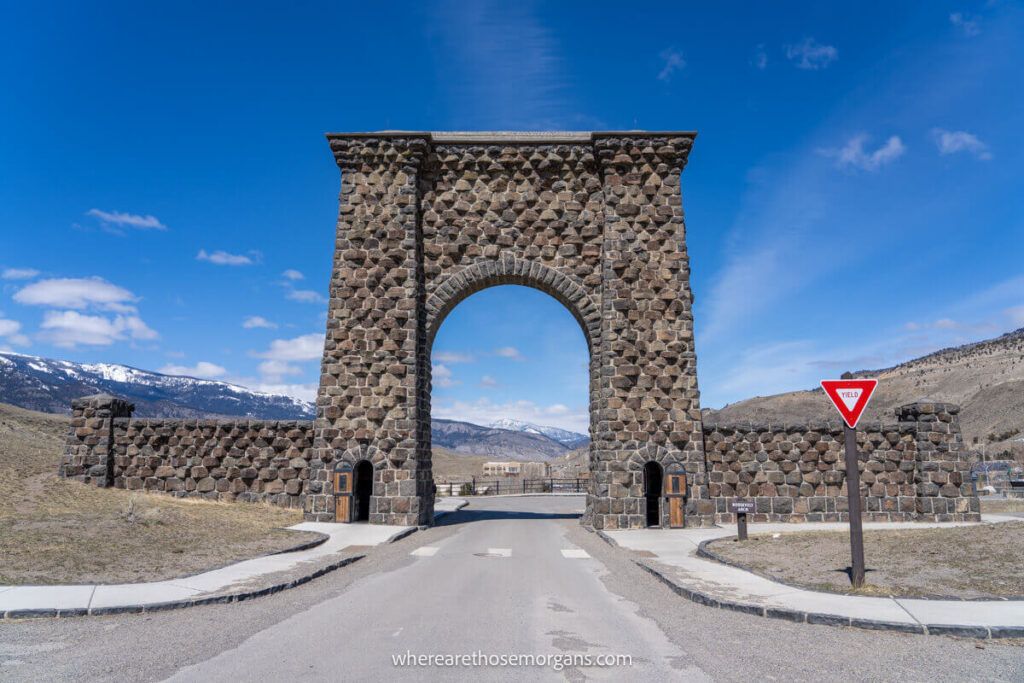
Here is a brief description about each entrance and which one you should use depending on how you plan to enter Yellowstone:
- West Entrance near West Yellowstone, Montana – The west entrance is the most commonly used entrance in Yellowstone due to it’s close proximity to West Yellowstone (located near Norris).
- North Entrance near Gardiner, Montana – This is the only Yellowstone entrance open year round and makes for a great option if you plan to fly into Bozeman (located near Mammoth).
- Northeast Entrance near Cooke City, Montana – The first time we visited Yellowstone, this is how we entered the park. You will travel along the stunning Beartooth Highway and enter near Lamar Valley.
- East Entrance near Cody, Wyoming – Use this entrance if you plan to fly into Cody, Wyoming or plan to visit Yellowstone Lake.
- South Entrance between West Thumb and Moran, Wyoming – This is the best entrance if you are flying into Jackson Hole or plan to visit Grand Teton National Park before Yellowstone.
Need help with your flight? Use our popular guide featuring the 10 best airports near Yellowstone to show you the best route.
Best Things To Do In Mammoth
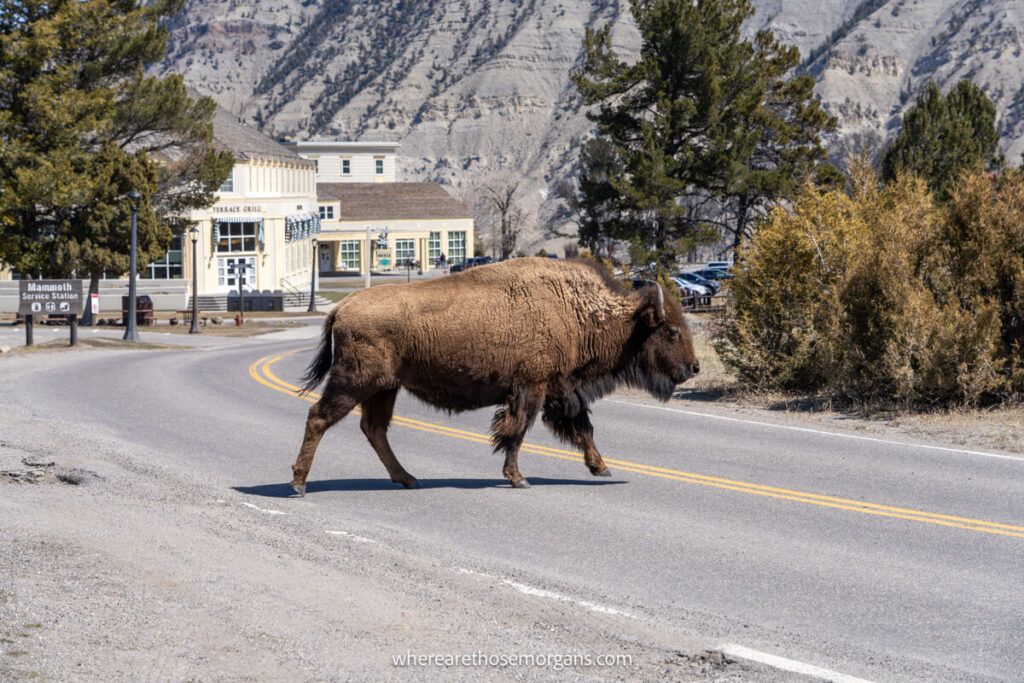
Mammoth is one of the major hubs for visitors to Yellowstone and this northern region is located close to Gardiner, Montana near the North Entrance.
Depending on the time of year you visit, Mammoth can be much quieter than other popular areas of Yellowstone.
If you time it right, you might see a herd of bison walking straight through town. We even saw numerous elk grazing in the middle of the village.
On our most recent visit in April 2021, we saw at least 20 bison dotted all around Mammoth Village. Just remember to give bison at least 25 yards and please, do not abandon your car in the middle of the road.
During our first visit when we stayed in a Mammoth Cabin, we had an large male elk with antlers eating about 30 meters from our porch area. So we silently watched him as we drank our morning coffee.
This is the only region of Yellowstone open to vehicles year round and features the popular Mammoth Hot Springs Hotel and Cabins.
Travel Tip: If you are entering the park from the Gardiner entrance, make sure you stop by the Roosevelt Arch which was named after president Theodore Roosevelt.
Here are the best places to visit in Mammoth Hot Springs:
1. Mammoth Hot Springs Trail
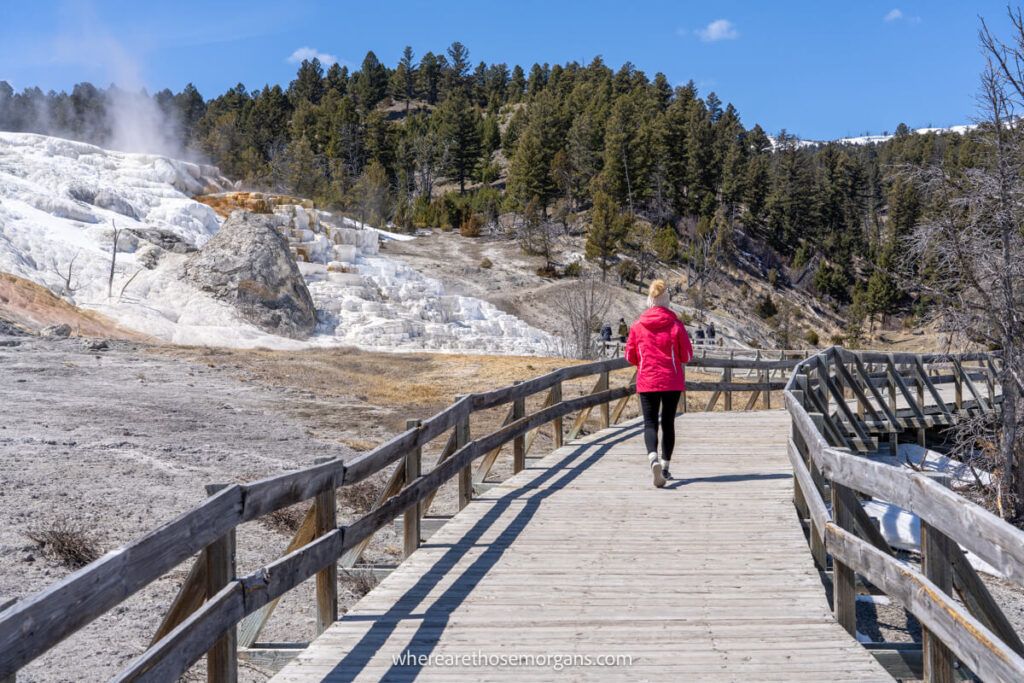
The Mammoth Hot Springs Trail is one of the best things to see in Yellowstone because you can explore roughly 20 hot springs via the Upper and Lower Terrace boardwalks.
Mammoth Hot Springs are popular because they are beautiful large travertine terraces. Geology and weather combine to create white chalky travertine terraces.
Important hydrothermal features in Mammoth include Liberty Cap, Canary Springs, Palette Spring, Orange Spring Mound and Minerva Terrace. We love the Main Terrace Overlook for the best views.
Here are a few tips for visiting Mammoth Hot Springs Trail:
- The boardwalks include steep grades and stairs, but certain sections can be accessed by wheelchair when there is no snow
- If you plan to walk from Lower to Upper Terrace, there are many stairs
- Sunrise is stunning at the Mammoth Upper Terrace hot springs
- Black bear sightings are common near the Upper Terrace area
2. Mammoth Village
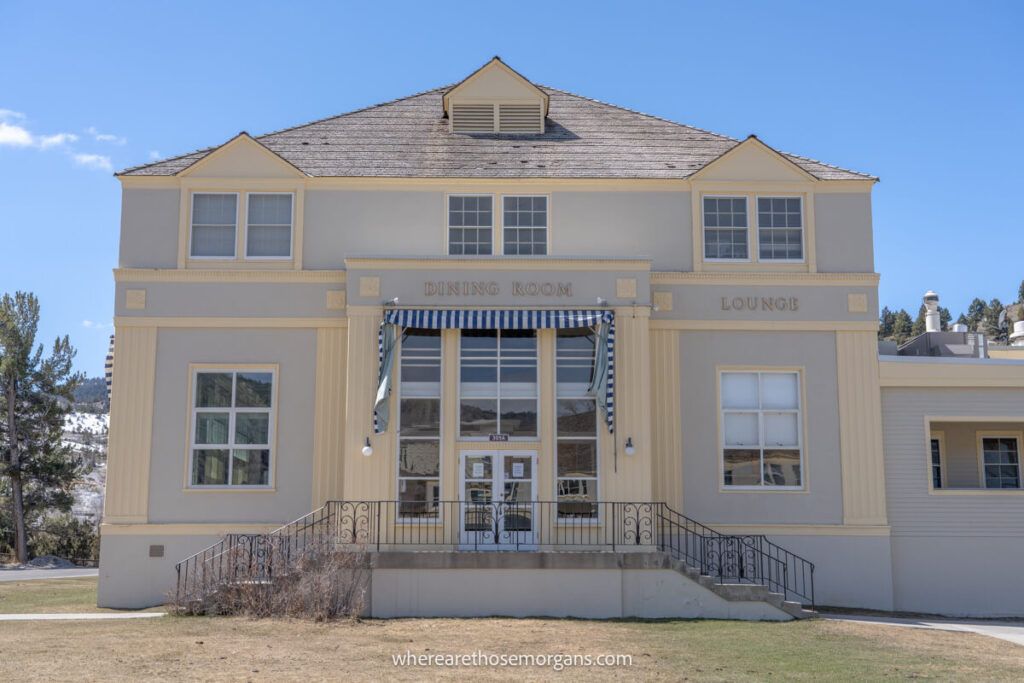
Mammoth Village is one of the most built up areas inside the Yellowstone park boundaries. We can almost guarantee you will see elk walking around the parking lot, near the hotel and dining hall.
The Mammoth Hot Springs Hotel and Cabins is a great choice for lodging, but you can also find the year round Mammoth Campground or the seasonal Indian Creek Campground located here.
If you are looking for a bite to eat, look no further than the Mammoth Hot Springs Dining Room which is open for breakfast, lunch or dinner in the summer and winter seasons.
We ate in the Mammoth Dining Room in October and while the food is a bit pricey, it is a convenient option for eating within the park.
3. Lava Creek Trail And Undine Falls
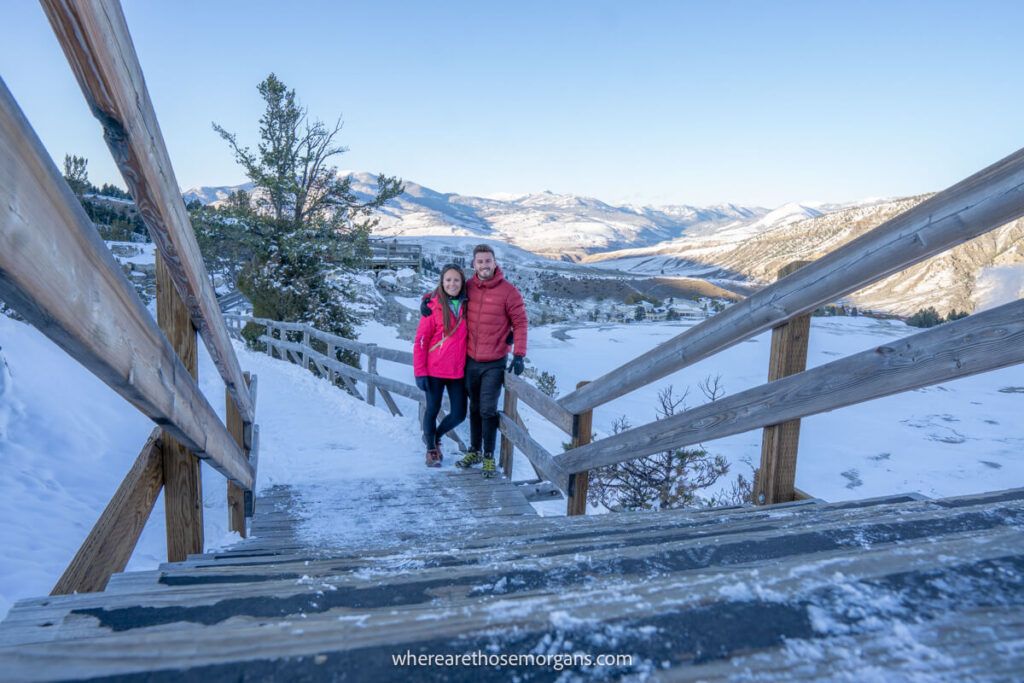
- Distance: 4.2 miles (one-way)
- Difficulty: Moderately strenuous
- Type: Out and back
- Elevation gain: 1,200 ft
- Time: 2-3 hours
The Lava Creek Trail is the best day hike around the Mammoth area. This trail follows the Gardner River to the confluence with Lava Creek and passes by Undine Falls.
Undine Falls is a very photogenic 60 ft multi-tier waterfall with its three-tier cascade. This is a relatively unknown wildlife spotting area away from the crowds of Lamar Valley and Hayden Valley.
The 4.2 mile one way trail runs running from Mammoth Village to Lava Creek Trailhead so it works well if one person drives while others hike one way to save coming back the same way.
Wildflowers and wildlife are abundent in summer, but this trail is often closed in the spring season due to high bear activity.
Here is what you need to know when hiking Lava Creek Trail to Undine Falls:
- Lava Creek trail begins along Grand Loop Road 4 miles east of Mammoth
- Undine Falls is located 4 miles east of mammoth on the way to Tower-Roosevelt
- Lava Creek meets Gardner River downstream and there is a steep climb at the end of the hike
- Th Undine Falls overlook is very popular but the Lava Creek hike is often quiet
Hiking Tip: If you don’t want to hike Lava Creek Trail, you can see Undine Falls from an overlook on the side of the road as you head east towards the Tower-Roosevelt region.
4. Boiling River
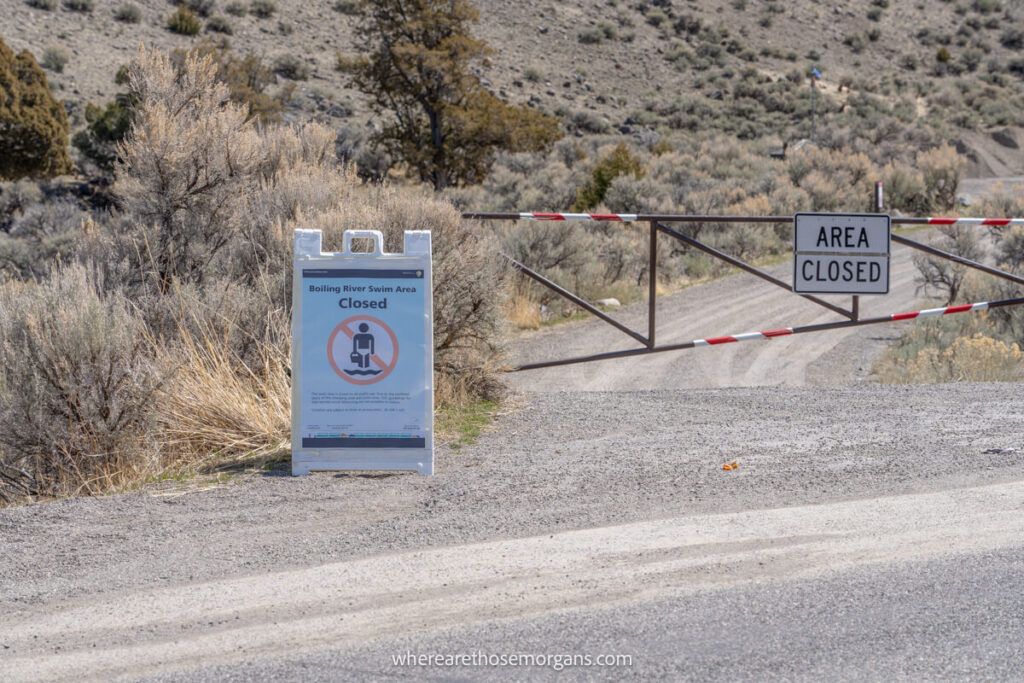
- Distance: 1.2 miles roundtrip
- Difficulty: Easy
- Type: Out and back
- Elevation gain: 75 ft
- Time: 30 mins
Boiling River is a very short and easy trail that leads to the best place to swim in Yellowstone National Park, the aptly named Boiling River.
At the Boiling River, very cold river water mixes with hydrothermal hot springs creating a very unusual temperature with pockets of icy cold then baking hot.
This has been one of the top Yellowstone attractions for years because the Boiling River is one of the only two places you can swim in the park.
However, the Boiling River is currently closed due to the June 2022 floods. Check the status of the Boiling River on the NPS website.
Here is what you need to know about the Boiling River:
- The Boiling River trailhead is near the 45th parallel sign between Mammoth and Gardiner
- Lifeguards are not present at swimming areas in Yellowstone National Park
- Be sure to bring swimsuits, water, flip flops and reef safe sunscreen
- Boiling River is a very popular spot when it is open
5. Tour Fort Yellowstone
If you are looking for a unique thing to do in Yellowstone, Mammoth Hot Springs is home Fort Yellowstone which is now listed as a National Historic Landmark District.
Built in the early 1900s, these buildings were originally used by the US Army when they protected the park including a guard house, office quarters, stables and barracks for enlisted men.
In 1918, the historic buildings of Fort Yellowstone became the parks first administration buildings. Many of the buildings in Fort Yellowstone are still used for Yellowstone’s main head quarters.
Use this self-guided tour to explore Fort Yellowstone if you are interested in the parks history. Keep in mind, many of the buildings are not open to the public and open buildings have accessible ramps.
Need help planning your trip to Yellowstone?
Our popular Yellowstone travel guidebook helps you with planning every aspect of your visit, including what to see in each region, where to eat and stay, itinerary ideas and map!
View Yellowstone Guidebook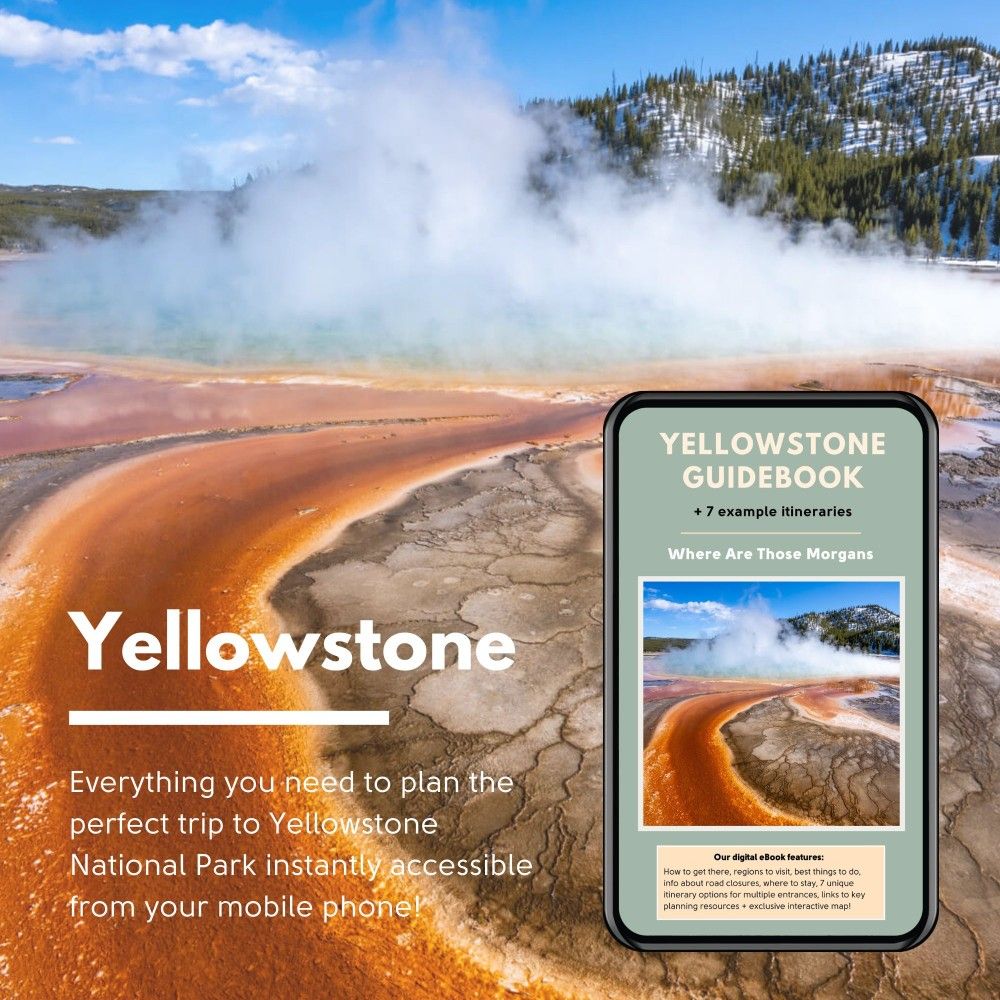
Best Things To Do In Tower
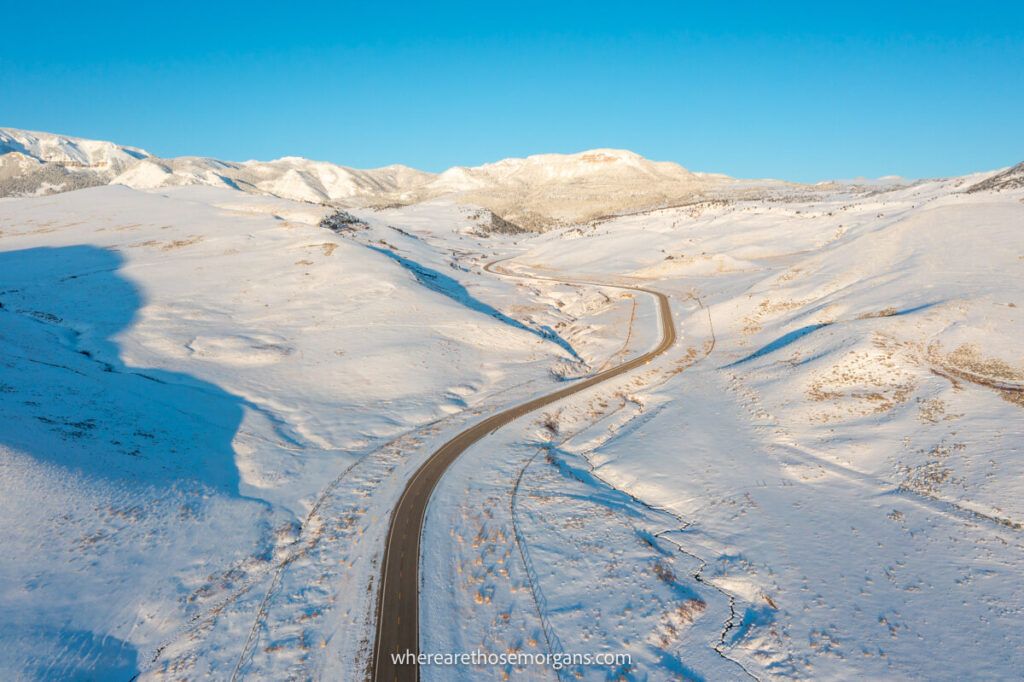
The Tower region in our Yellowstone guide includes the Tower-Roosevelt region near the northeast entrance of the national park.
This is a quieter section of the park because there are fewer activities in this area. But it is important to note the road between Gardiner and Cook City is open all year.
However, the Beartooth Highway closes mid-May to October. This 68 mile stretch of road begins at the north east entrance of Yellowstone and terminates in Red Lodge, Montana.
Travel Tip: If you are planning to drive the Beartooth Highway, it will take about 2-3 hours. You will pass through national forests and have the option to add additional hikes onto your itinerary.
Here are the best places to visit in Tower-Roosevelt:
6. Blacktail Plateau Drive
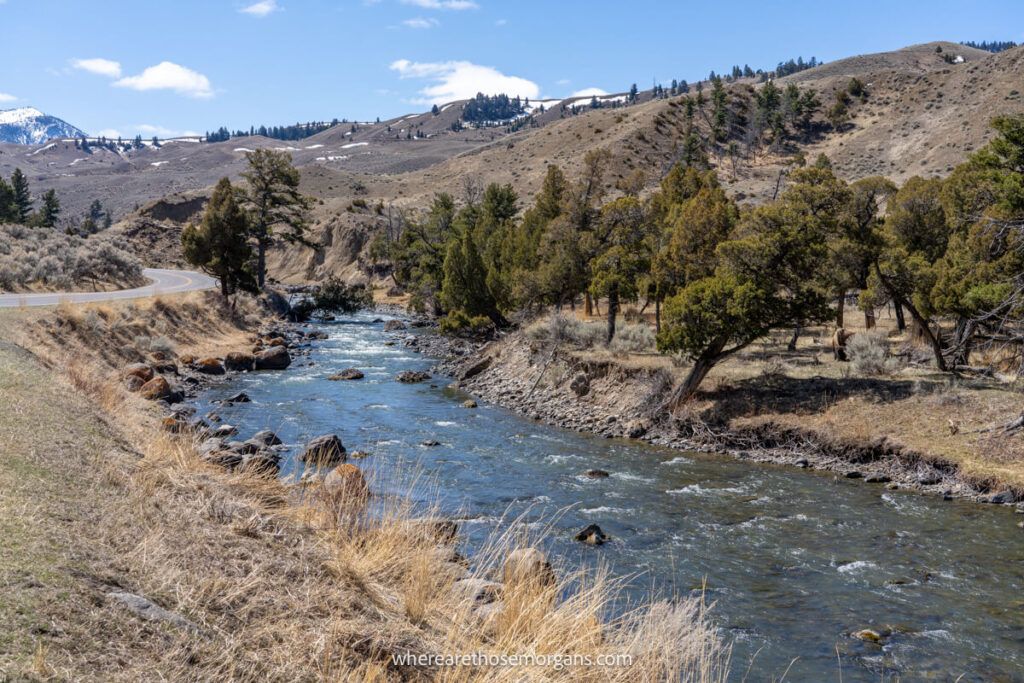
The Blacktail Plateau Drive in Yellowstone is a scenic unpaved 6.0 mile one way road showcasing both alpine forest and gorgeous meadows.
If you are coming from the Mammoth Hot Springs region, this drive is certainly a more rustic way to arrive in Tower-Roosevelt. Wildlife is common along Blacktail Plateau Drive so please drive responsibly.
Travel Tip: Blacktail Plateau Drive is a bear management area in Yellowstone and this scenic route is only open during the summer season.
7. Lamar Valley
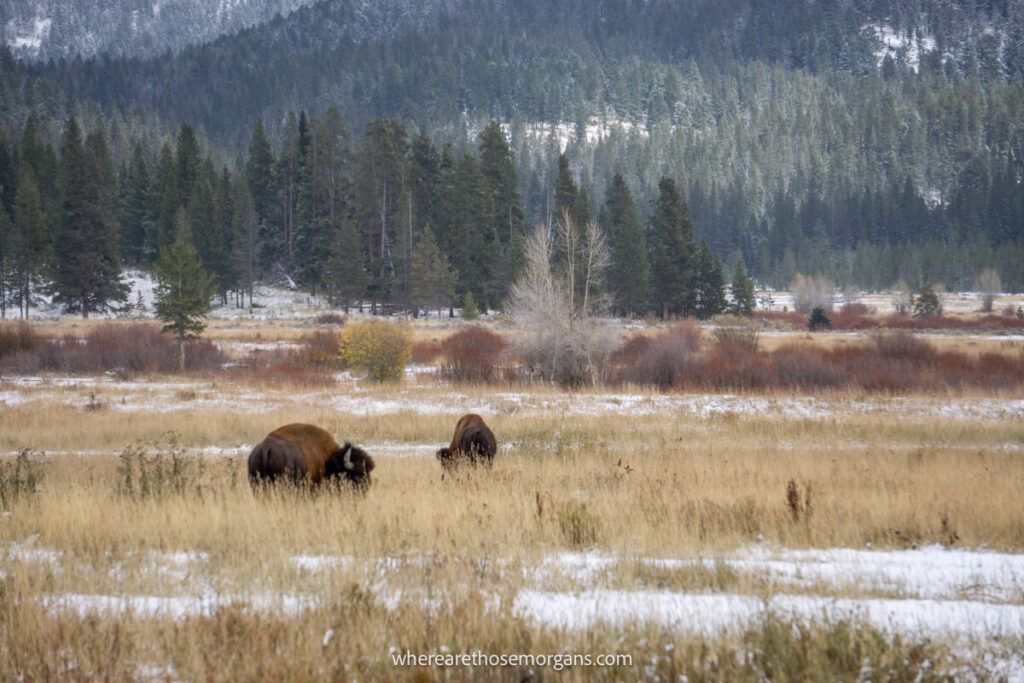
Animals are like celebrities in Yellowstone National Park and there’s no better place to go celebrity spotting than Lamar Valley.
The Lamar Valley is often where you have the best chance to see wildlife including grizzly bears, wolves, pronghorn and of course, bison.
If you enter or leave the park via the northeast entrance (Cooke City), you will drive through Lamar Valley. Keep this in mind when creating your Yellowstone itinerary.
Our best advice for Yellowstone wildlife spotting is to arrive very early in the morning. You will stand a much greater chance of seeing wildlife in the dawn hours, especially in the Lamar Valley.
Here are tips for visiting the Lamar Valley:
- Lamar Valley is located between Tower-Junction and Cooke City
- Early morning and late evening are the best times to see wildlife
- If you are visiting from 10:00am – 4:00pm on a hot summer day, there is very little chance of seeing animals (except maybe bison)
- Bring binoculars or a telephoto lens to safely view animals from a distance
Travel Tip: If the roadside is jam packed with cars and people wanting to see animals, get off the roadside. Park at Specimen Ridge and hike a few hundred meters away from the road instead.
8. Petrified Tree
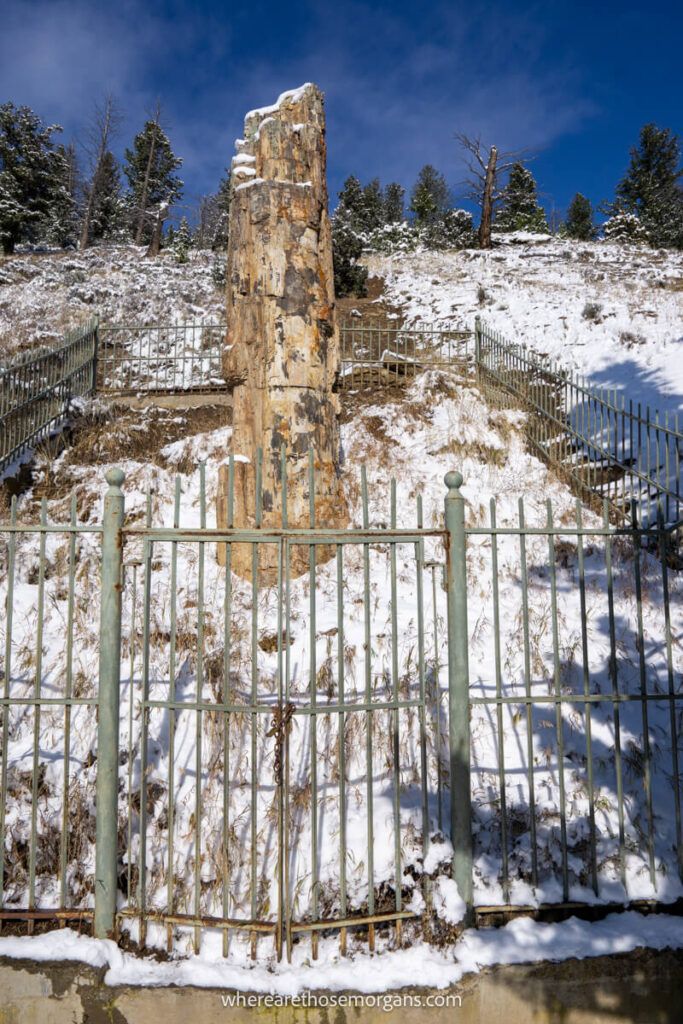
One of the best places to go in Yellowstone that many people often miss is the Petrified Tree exhibit along the Grand Loop Road in the Tower-Roosevelt region.
We like this roadside exhibit in Yellowstone because you can learn about how the tree was formed. While the remains of this tree doesn’t look like much, it is actually a very important part of Yellowstone.
Nearby, Specimen Ridge is home to the worlds largest concentration of petrified trees. Over 100 species of plants have been found here.
So this ancient redwood remnant can help us learn about the history of Yellowstone’s violent volcanic past.
Hiking Tip: If you want to see more petrified trees, use the 3.0 mile hiking route located 4.5 miles east of Tower Junction in a striped pullout. You will hike to an outcrop of petrified trees.
9. Tower Fall
Tower Fall is arguably the second most attractive waterfall in Yellowstone after Lower Falls. This stunningly narrow waterfall features a 132 ft single drop plunge surrounded by trees and canyon walls.
Severe erosion means trails to the bottom of Tower Fall are now closed to the public. But a viewing point is easily accessible and is located just 100 ft from the parking lot.
You can also walk past the overlook for 0.75-miles to see Tower Fall landing inside the Yellowstone River. A stop at Tower Fall is certainly a Yellowstone must see attraction.
Here are tips for visiting Tower Fall:
- Tower Fall is located near Tower Junction in northeast Yellowstone
- Couple a visit to Tower Fall with hiking Mount Washburn (when open)
10. Specimen Ridge Trail
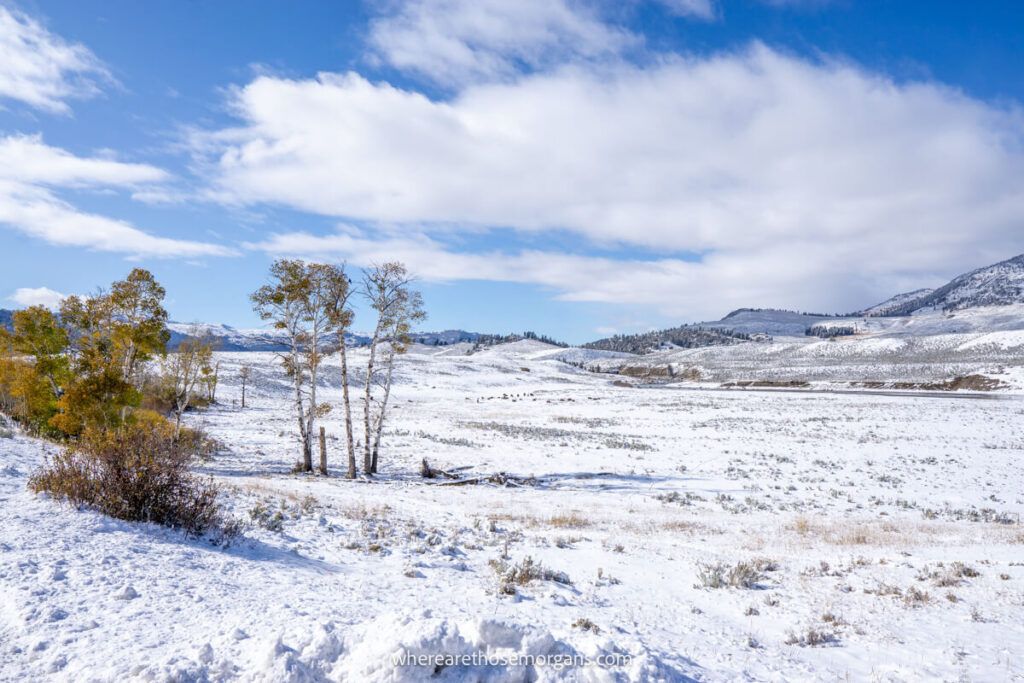
- Distance: 16.9 miles one way
- Difficulty: Strenuous
- Type: Point to point
- Elevation gain: 3,850 ft
- Time: 9 hours
Specimen Ridge is a very long strenuous hike through Lamar Valley. You can fully expect to see various forms of wildlife, including bighorn sheep, elk, pronghorn, bison and grizzly bears.
This is a beautiful trail with stunning views, wildflowers and a bit of an adventure because you will have to cross the river. But plan for this hike to take up an entire day on your Yellowstone itinerary.
We recommend this trail only if you are an experienced hiker and know how to use bear spray. You should also use one of our recommended apps for hiking to navigate the trails along with a paper map.
Here is what you need to know when hiking Specimen Ridge:
- The Specimen Ridge trailhead is located very close to Tower-Roosevelt near Lamar Valley
- This is a long day hike through Yellowstone’s backcountry and you will probably encounter wildlife
- Always carry the 10 hiking essentials including bear spray
Hiking Tip: Do not confuse this long hike with the 3.0 mile roundtrip Specimen Ridge Day Hike leading to petrified trees.
Best Things To Do In Canyon
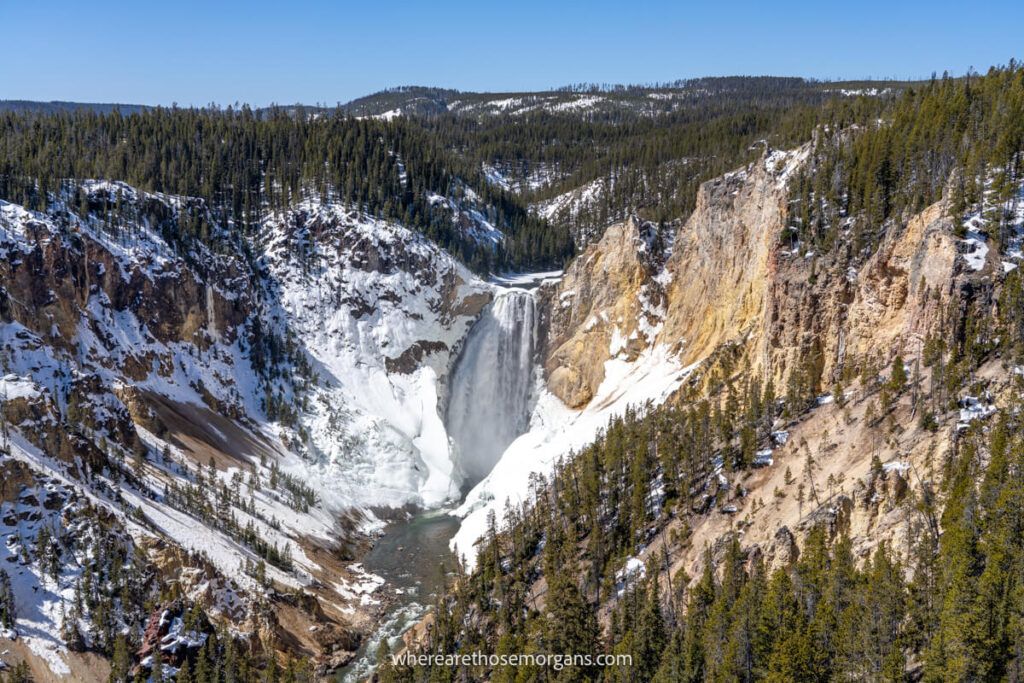
Canyon Village is one of the best places to visit in Yellowstone National Park because there are many of activities in this region and it is centrally located.
The major highlight of this Yellowstone region is the Grand Canyon of the Yellowstone River, but we also love Hayden Valley and the Mud Volcano Trail.
Here are the best places to visit in Canyon Village:
11. Grand Canyon Of The Yellowstone River
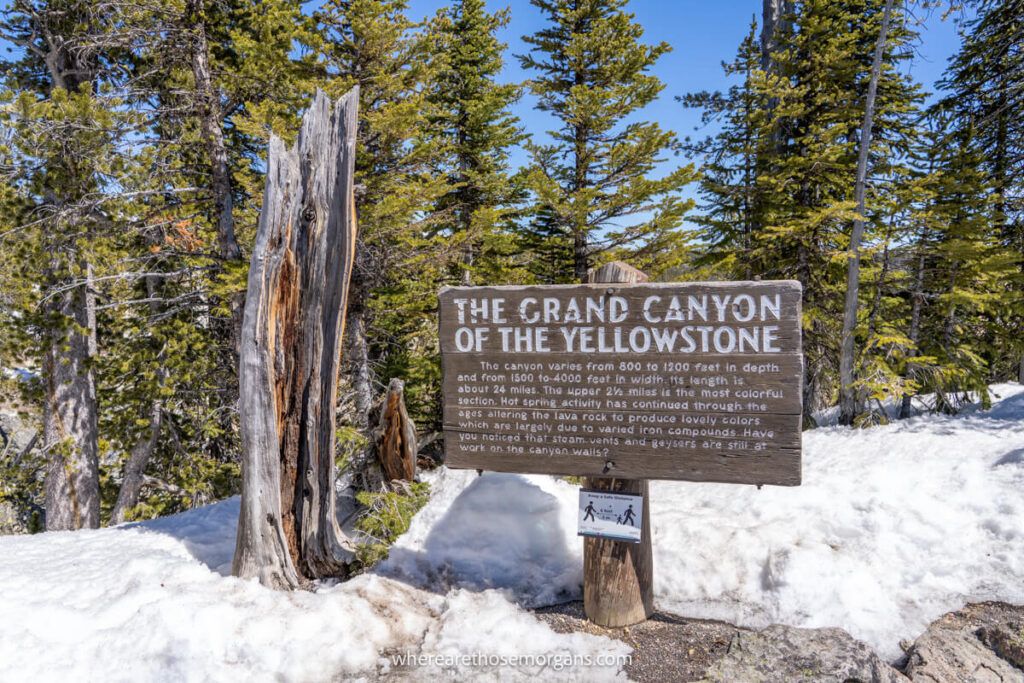
Grand Canyon of the Yellowstone featuring Upper and Lower Falls is hands down one of the best things to do in Yellowstone National Park.
The Grand Canyon of the Yellowstone has numerous viewpoints so it is without a doubt one of the best Yellowstone activities you must visit because they are easily accessible.
We recommend you drive both North Rim and South Rim drive, stopping off at each viewpoint and soaking up views into the breathtaking canyon.
Our personal favorite viewpoint is Artist Point on South Rim Drive. This where you would find us at sunrise with our camera and tripod, even on a freezing cold October morning.
Here are tips for visiting the Grand Canyon of Yellowstone:
- Grand Canyon of the Yellowstone is located near Canyon Village
- Sunrise is special in the canyon, especially if you get lucky with clouds and weather
- Uncle Tom’s Trail has been closed since 2019 and looks unlikely to open anytime soon
- You should visit both the brink of Lower Falls and brink of Upper Falls
- Bald eagles nest around the bridge area crossing the Yellowstone River as you enter South Rim drive
12. Hayden Valley
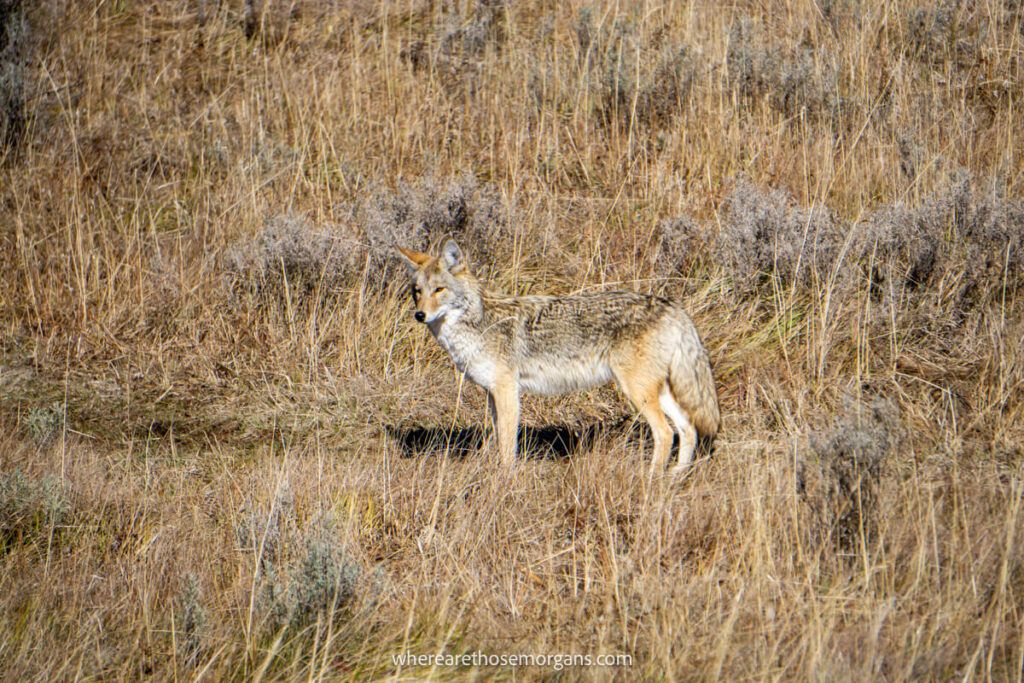
Lamar Valley is the undisputed primetime wildlife spotting arena but Hayden Valley is widely regarded as the second best place to see wildlife in Yellowstone National Park.
We recommend you visit Grand Canyon of the Yellowstone for sunrise, before driving a few minutes south into Hayden Valley to spot wildlife as they begin their daily routines around dawn.
This is what we did on both of our Yellowstone visits and we have seen saw bison, bald eagles and a lone coyote in Hayden Valley.
Here are tips for visiting the Hayden Valley:
- Hayden Valley is located between Canyon Village and Yellowstone Lake
- Early morning and late evening are the best wildlife viewing times
- Stick close to the Yellowstone River to see bald eagles nesting
- Bison often hang out in large herds around Hayden Valley meadows
13. Mud Volcano
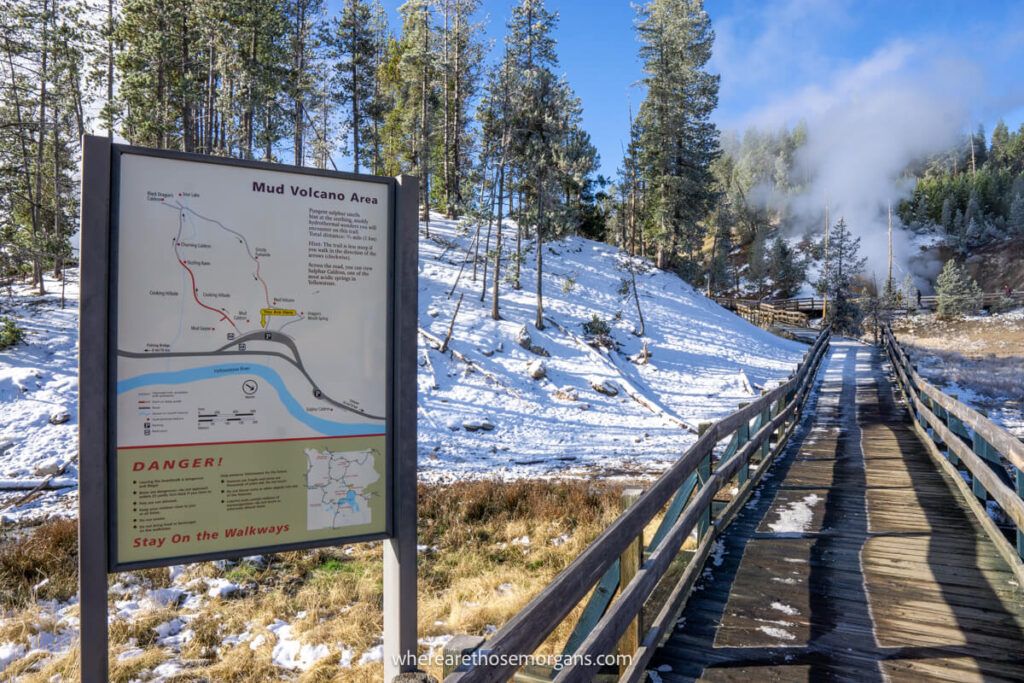
Mud Volcano makes up the second of two thermal Yellowstone attractions on the eastern side of the park (along with West Thumb which we will cover later).
We find Mud Volcano to be a complete contrast to West Thumbs calmness and still waters, but a visit to the Mud Volcano Trail is certainly one of the best stops in Yellowstone.
You can expect loud, gargling and unruly bubbling mud pots, plus smelly acidic geysers here at Mud Volcano.
Important hydrothermal features at Mud Volcano include Mud Cauldron, Cooking Hillside and Grizzly Fumarole and Dragon’s Mouth Spring.
We think the best feature is the small vent blowing out a large amount of hot steam known as Dragon’s Mouth Spring. You will understand how this feature got it name the second you hear it.
Here are tips for visiting Mud Volcano:
- Mud Volcano is located between Canyon and Yellowstone Lake near the Hayden Valley
- This is another quiet area, but definitely worth a visit
- Don’t miss the eye catching volume of steam billowing our of Dragon’s Mouth
14. Mount Washburn Via Dunraven Pass
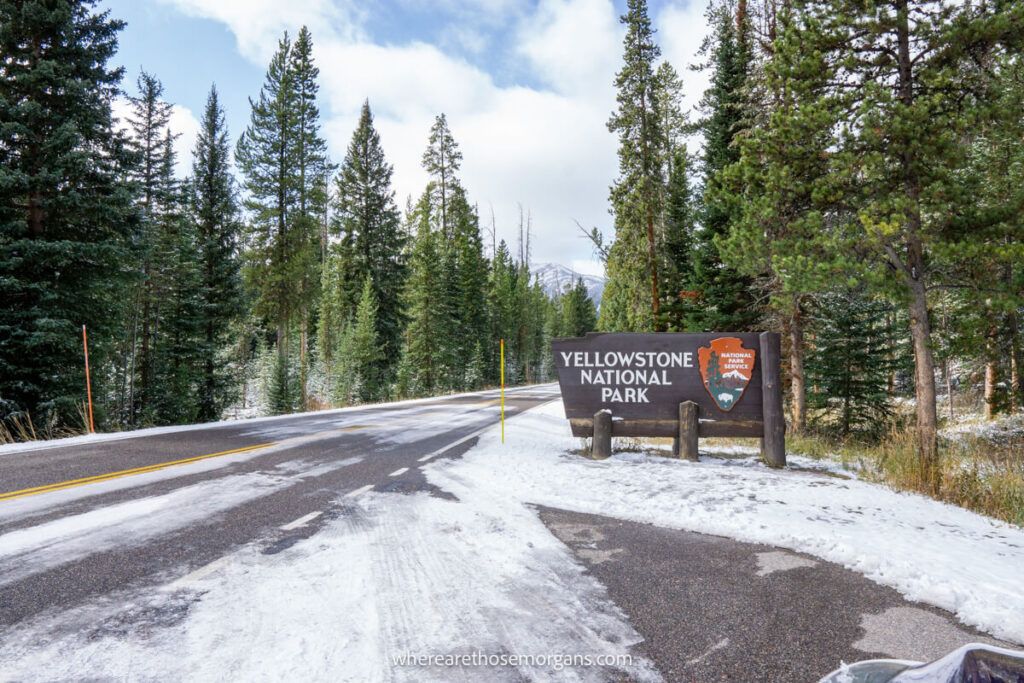
- Distance: 6.0 miles roundtrip
- Difficulty: Strenuous
- Type: Out and back
- Elevation gain: 1,343 ft
- Time: 3-6 hours
Mount Washburn is the most popular day hike in Yellowstone National Park. The goos news is this trail is finally back open in 2022 after a few years of closure to the public.
The Mount Washburn summit can be reached via two trails:
- Dunraven Pass (6.0 miles)
- Chittendon Road (5.0 miles)
If this is your first time visiting Yellowstone, we recommend hiking the Dunraven Pass route. This trail is so popular it even has its own parking lot alongside Grand Loop Road.
Views from the summit are spectacular, with a 360 panoramic vista over Yellowstone making it one of the best things to do in the park and one of the best hikes in the US.
Here is what you need to know when hiking Mount Washburn:
- Mt Washburn Trail via Dunraven Pass is located between Canyon and Tower-Roosevelt
- Parking fills very quickly so be sure to arrive early
- Stay on the trail to avoid destroying fragile vegetation
- Interpretive exhibits are located at the base of the fire lookout
- There is no water access along the Mount Washburn hike
Hiking Tip: Grizzly bears frequent the area around Mount Washburn in fall looking for whitebark pine nuts so hiking this trail in September or October is not recommended.
15. Canyon Village General Store
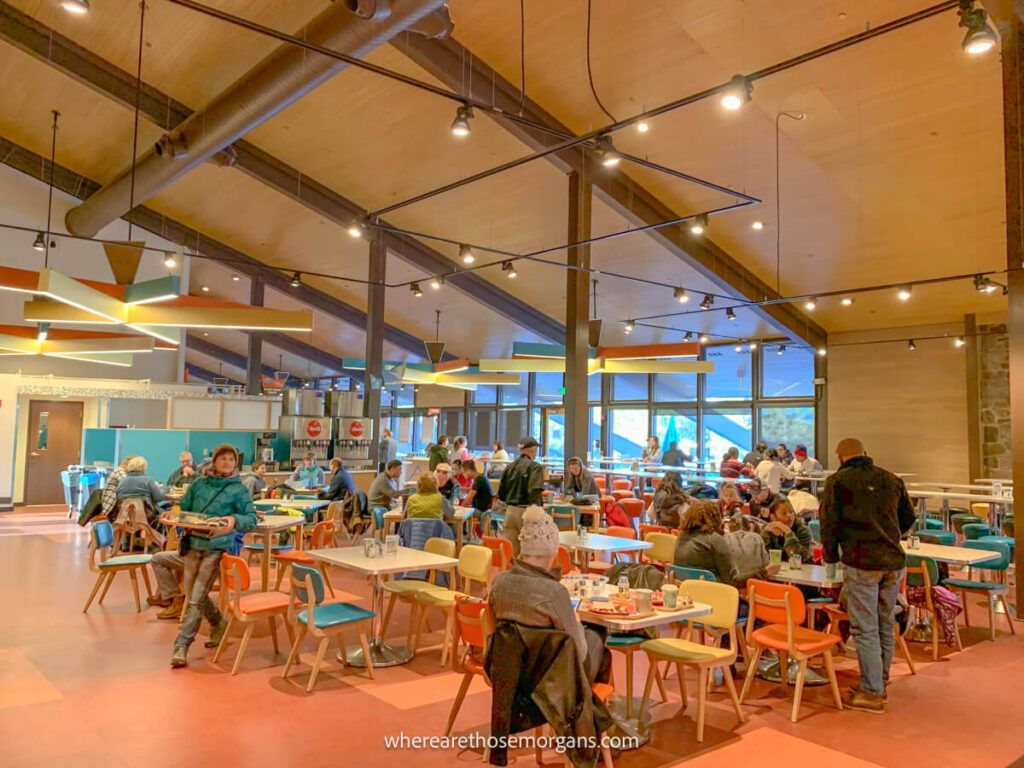
A great place to visit in Yellowstone with the family is Canyon Village General Store. This may not be your typical stop in Yellowstone but we like this store for the nostalgic vibe.
Opened in 1957, this is one of the original stores in Yellowstone National Park that still sells groceries, ice cream, souvenirs and NPS apparel. When visiting the store, make sure you snap a photo with Billy the Bison!
We also love the 1950’s themed counter-style sit-down restaurant, the Canyon Fountain and Grill. This is probably one of the best places to eat in Yellowstone based on price and food available.
Love the national parks? You should consider a National Parks Passport to document your amazing adventures.
16. Cascade Lake
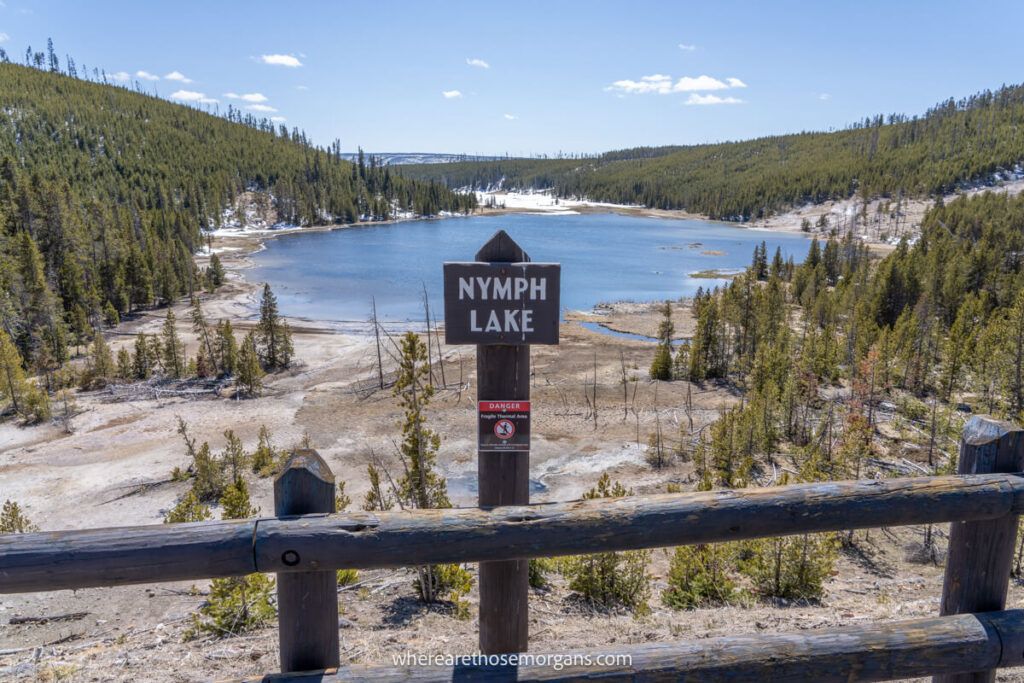
- Distance: 4.4 miles roundtrip
- Difficulty: Easy
- Type: Out and back
- Elevation gain: 250 ft
- Time: 2-3 hours
Canyon Village can be an extremely busy region in Yellowstone so if you are looking to get away from the crowds, an easy hike to Cascade Lake could be part of your Yellowstone to do list.
We like this trail because it passes through open meadows and you will find an abundance of wildflowers in summer. Cascade Lake is also be a great place for spotting wildlife in Yellowstone National Park.
For hikers looking to take on a more challenging route, you can continue along this route to Observation Peak. This hike climbs 1,400 ft in 2.6 miles, but it can be very snowy and wet even until mid-July.
Best Things To Do In Norris
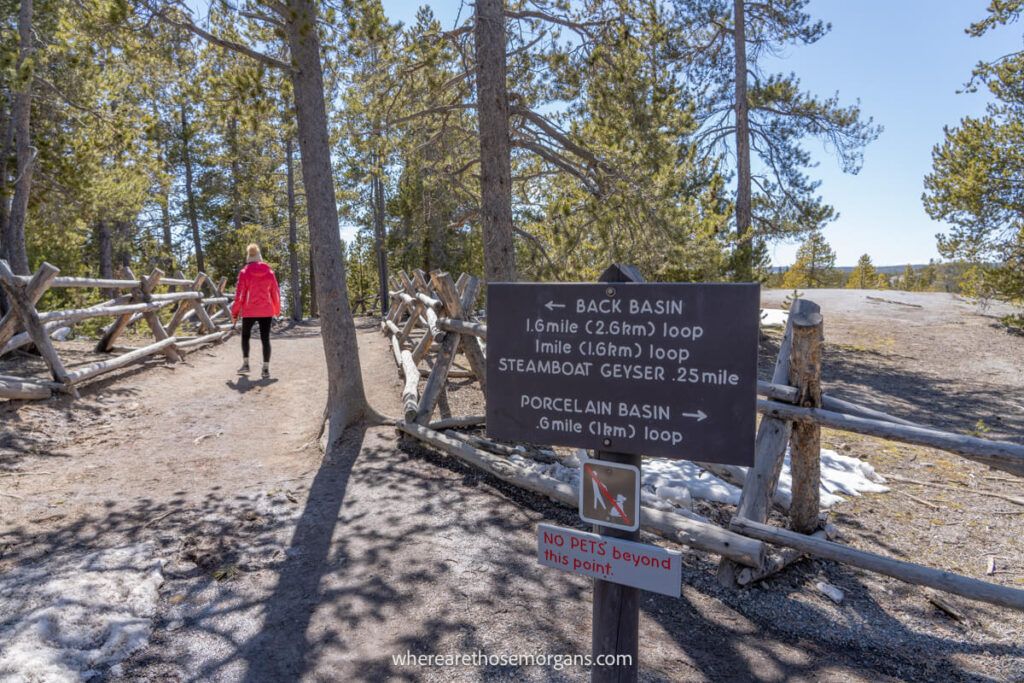
In this guide, the Norris region of Yellowstone National Park includes both the Norris Geyser Basin and Madison.
Walking around the amazing thermal areas at Norris Geyser Basin is one of the best things to do in Yellowstone because Norris is home to the hottest and oldest recorded thermal features.
We think the Norris Geyser Basin is one of the best spots to visit in Yellowstone so be sure to add this region to your itinerary.
There are two main boardwalks at the Norris Geyser Basin:
- Back Basin
- Porcelain Basin
Back Basin is the longer loop along which you will see the two most popular Norris geysers, the Steamboat Geyser and Echinus Geyser.
Along Porcelain Basin all of your senses will be heightened with acidic smells, bubbling sounds and eye catching colors.
Madison is a quieter section in Yellowstone National Park, but this is where you will find another great swimming spot and hidden waterfall.
Here are tips for visiting Norris Geyser Basin:
- Norris Geyser Basin is located close to the West entrance, where the road to Canyon begins
- It doesn’t matter which basin you start with, both have loop boardwalks
- Geysers here don’t erupt on schedule so you might want to hang around for a while
- Norris offers some of the best bang for your buck with plenty of geysers and very little walking
17. Steamboat Geyser
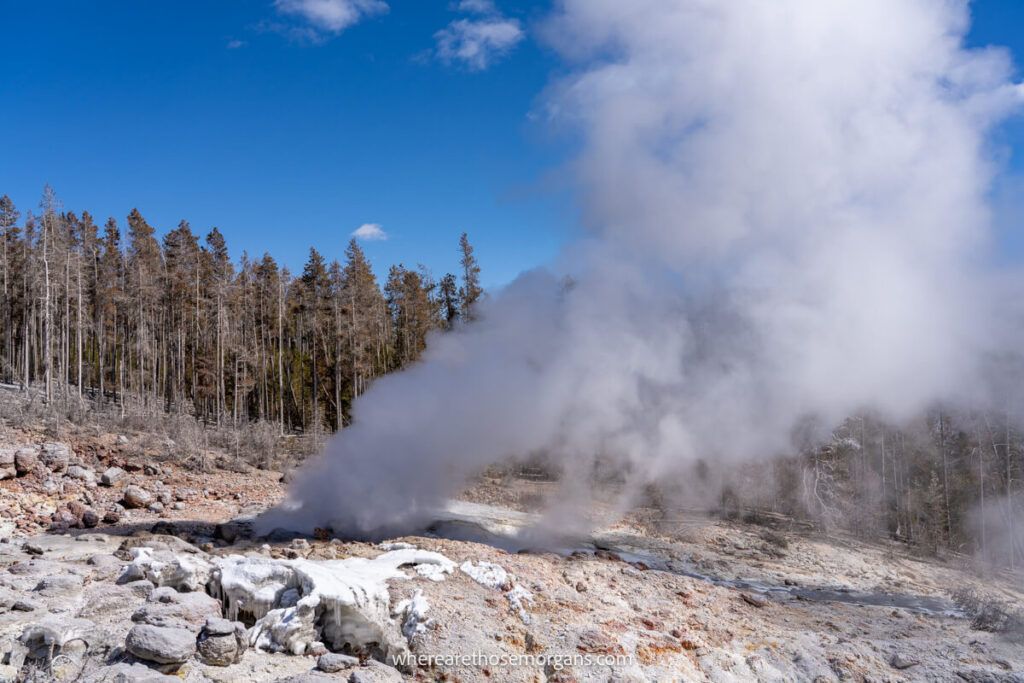
Steamboat is the tallest active geyser in the world and this hydrothermal showcases the best of Yellowstone in a single jet of powerful steam.
The eruptions of Steamboat Geyser send water soaring more than 300 ft. This geyser experiences both major and minor eruptions, but major eruptions are unpredictable.
Be careful if you are in this region when the Steamboat Geyser has a major eruption because debris can reach the cars in the parking lot damaging glass and paint on vehicles.
Travel Tip: The nearby Cistern Spring drains during and after a major Steamboat eruption.
18. Echinus Geyser
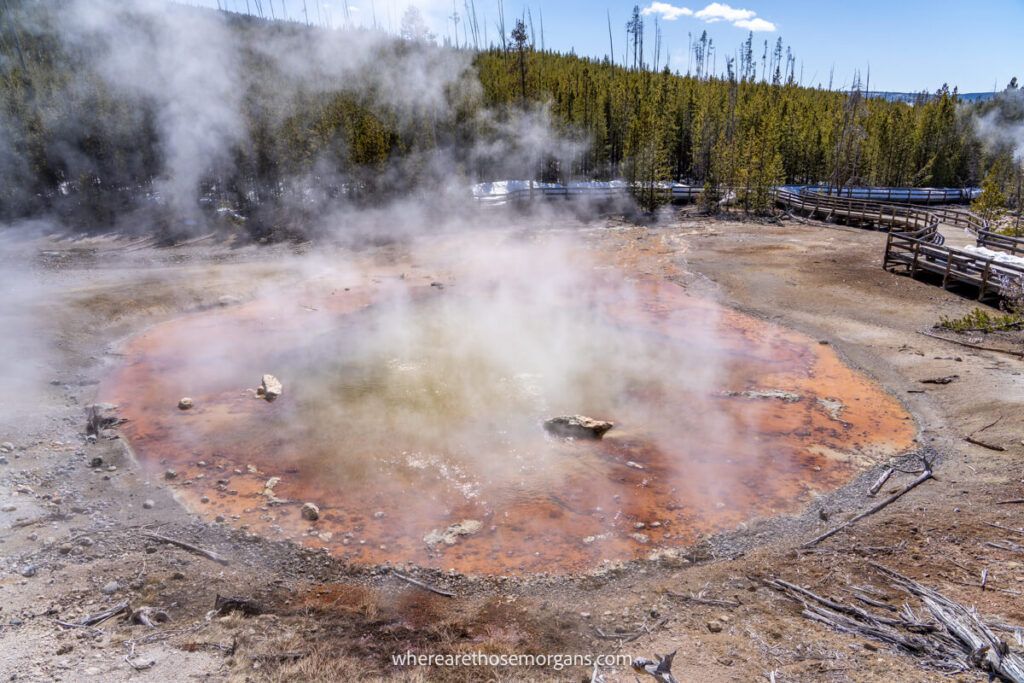
Echinus is the largest acid geyser in the world with a PH around 3.5. This geyser used to erupt every 35 – 75 minutes, but in 1998, it become much less frequent and predictable.
Today, eruptions of the Echinus Geyser are incredibly infrequent. However, when Echinus erupts you will see its pool fill gradually with water followed by bursts of steam reaching 60 ft.
Acidic geysers are extremely rare and this area contains the majority of the worlds acidic geysers so be sure to add the Norris Geyser Basin to your must see in Yellowstone National Park.
19. Gibbon Falls
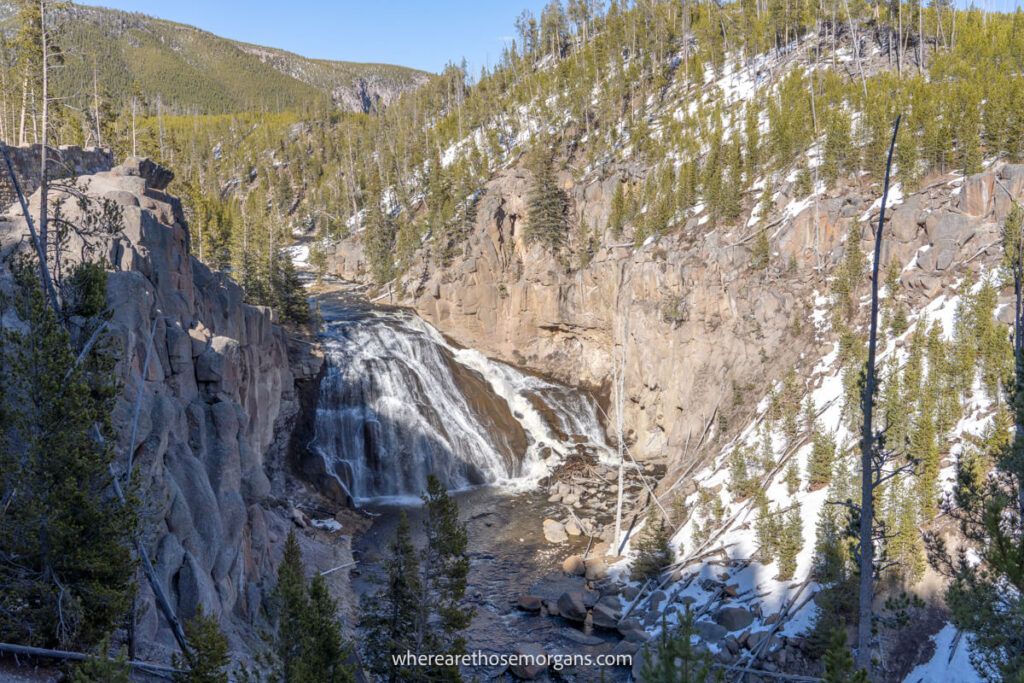
Gibbon Falls is one of the smaller waterfalls in Yellowstone National Park but it is one of the easier falls to visit. You can expect a wide sloped waterfall dropping over 80 ft into the Gibbon River.
Parking is plentiful near the waterfall but this is a very popular stopping off point between Norris Geyser Basin and Lower Geyser Basin.
A short walk along a paved path leads you to a viewing platform from which you can see the entirety of the falls.
Here are tips for visiting Gibbon Falls:
- Gibbon Falls is located near the Junction to West Yellowstone
- This is a popular stop off so if you find a parking spot, quickly take it
- A visit here will take no longer than 10-20 minutes
- Arctic grayling were historically common in the Gibbon River
20. Artist Paint Pots
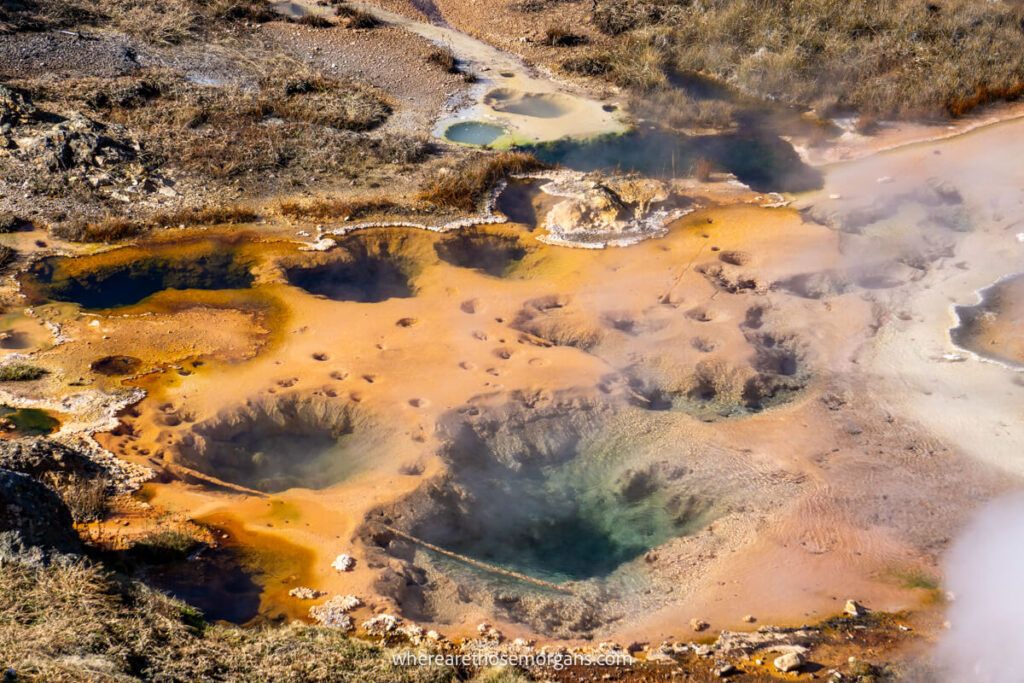
We consider Artist Paint Pots a hidden gem in Yellowstone and one of the best things to do in the park.
A short 1.0 mile roundtrip trail through forest leads to a colorful geothermal oasis, with small but incredibly vibrant pools and grey bubbling mud cauldrons.
Walk around the colorful pools that look as though they are on an artists pallet, climb up a short hill to see hot bubbles bursting and a wonderful bonus with spectacular views over Yellowstone.
Here are tips for visiting Artist Paint Pots:
- Artist paint pots is just over 3 miles south of Norris Geyser Basin
- This area is not one of the famous stops so it’s not as crowded
- Parking is fairly limited and it will fill in peak summer months
- Make sure you go behind the paint pots to see close ups of bubbling mud
21. Firehole Canyon River Drive
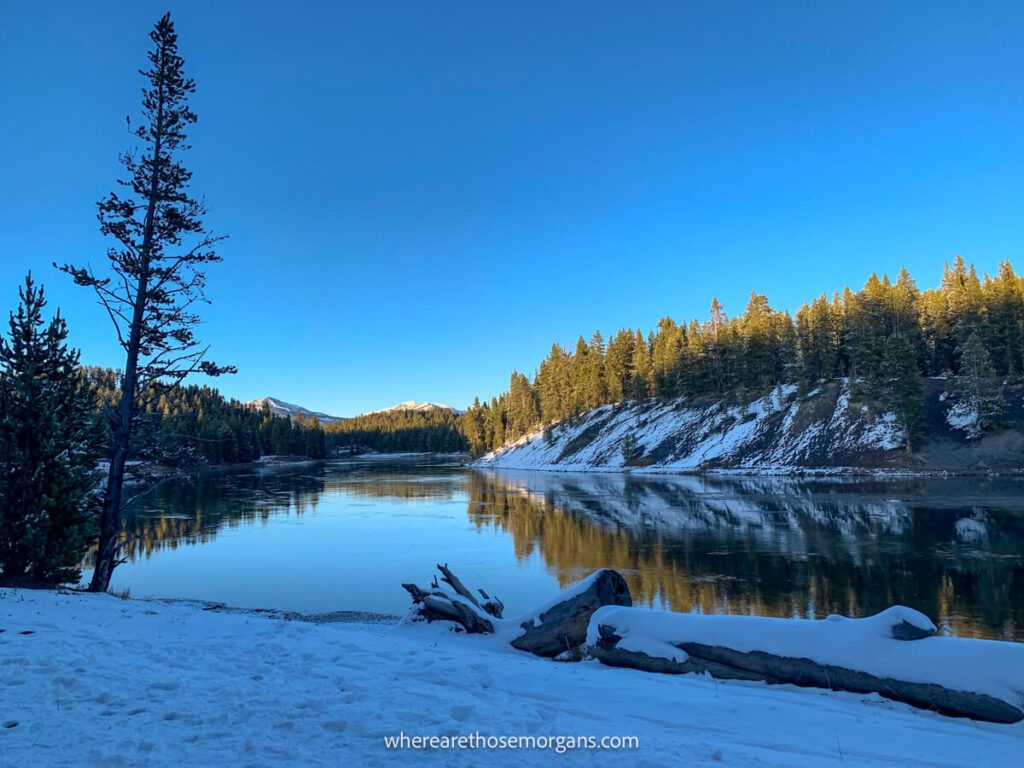
Firehole Falls is a 40 ft waterfall located along Firehole Canyon Drive (not to be confused with Firehole Lake Drive), but the waterfall is only half of the fun.
After visiting Firehole Falls, which is impressive and surrounded by rock walls, continue along the one way road until you reach one of only two places you can swim inside Yellowstone, the Firehole Swimming Area.
This area is not manned by lifeguards, but the water is comfortable for swimming. However, this swimming spot can get very busy and swimming is only permitted during the day light hours.
If Yellowstone has experienced significant snowpack and runoff, the Firehole swim area may remain closed for the entire season. The NPS always recommends life jackets and water wings.
Here are tips for visiting Firehole Canyon Drive:
- Swimming is at your own risk, but you will often see many people swimming here
- Firehole Canyon Drive is located very close to Madison Campground
- You won’t be able to get very close to Firehole Falls so bring a telephoto lens
- This is an short easy drive off the beaten Grand Loop Road
Travel Tip: The Firehole River is typically closed for swimming until mid-summer due to strong temperatures and high water. Always check current conditions before swimming.
22. Purple Mountain Trail
- Distance: 6.4 miles roundtrip
- Difficulty: Strenuous
- Type: Out and back
- Elevation gain: 1,500 ft
- Time: 3-5 hours
Beginning north of Madison Junction, this difficult hike climbs 1,500 ft in 3.2 miles.
But hikers will be rewarded with the best of Yellowstone park featuring panoramic views of the Gibbon and Madison river at the summit.
Best Things To Do In Old Faithful
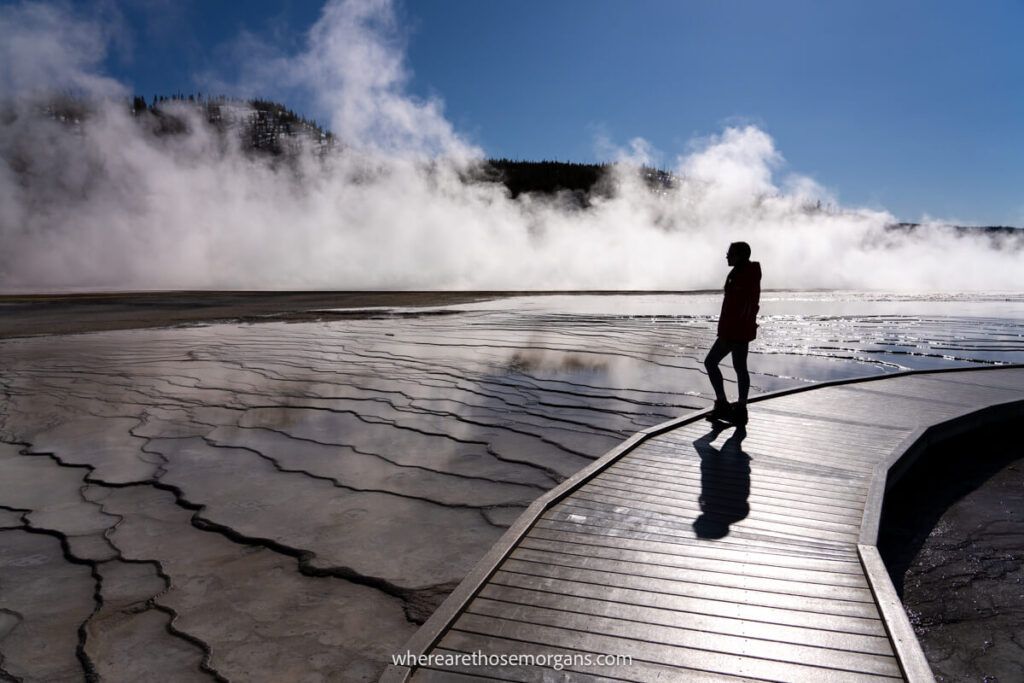
The Old Faithful region is the Yellowstone main attraction. In our guide, we included the Old Faithful region to include the Lower, Midway and Upper Geyser Basin to keep things simple.
You can expect this region of the park to be extremely busy, even in the shoulder seasons. But you will also find many amenities, services, restaurants and hotels so this is a great Yellowstone base.
23. Lower Geyser Basin
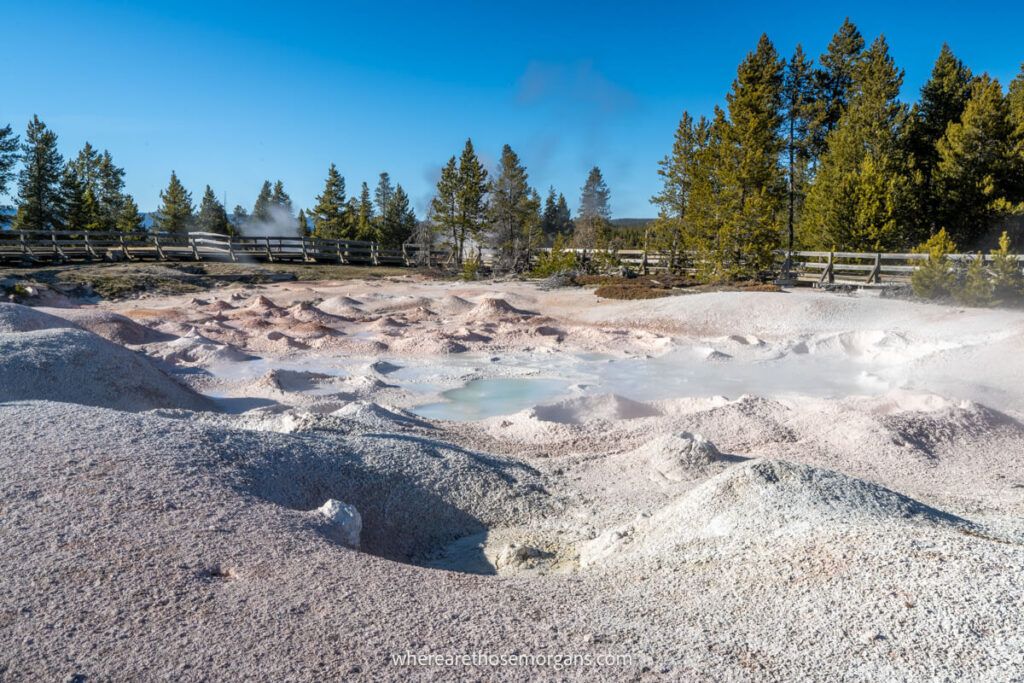
The Lower Geyser Basin of Yellowstone is the largest of Yellowstone’s basins when compared by area. This basin discharges more hot water per minute than any other section in the park.
The main boardwalk trail in the Lower Geyser Bain is called Fountain Paint Pots. This easy trail features a 0.6 mile easy flat walking path which originates directly in the parking lot.
Don’t miss this must do in Yellowstone because Fountain Paint Pots is one of the few areas in the park where you can find all five hydrothermal features including powerful geysers, colorful springs, bubbling mud pots and hissing fumaroles.
Firehole Lake Drive accounts for the other side of Lower Geyser Basin. One of the most popular sunset spots in Yellowstone is Great Fountain Geyser along this road.
Great Fountain Geyser is a cool place to see in Yellowstone National Park because this flat, wide and still geyser reflects the sun, clouds and colors perfectly if you get lucky at sunset.
Here are tips for visiting Lower Geyser Basin:
- The Lower Geyser Basin is located between Madison and Old Faithful to Yellowstone’s southwest
- Firehole Lake Drive is only open in summer and early fall
- The Lower Geyser Basin does not take long to visit
- Sunset is very popular at Great Fountain Geyser so photographers should arrive early
24. Midway Geyser Basin
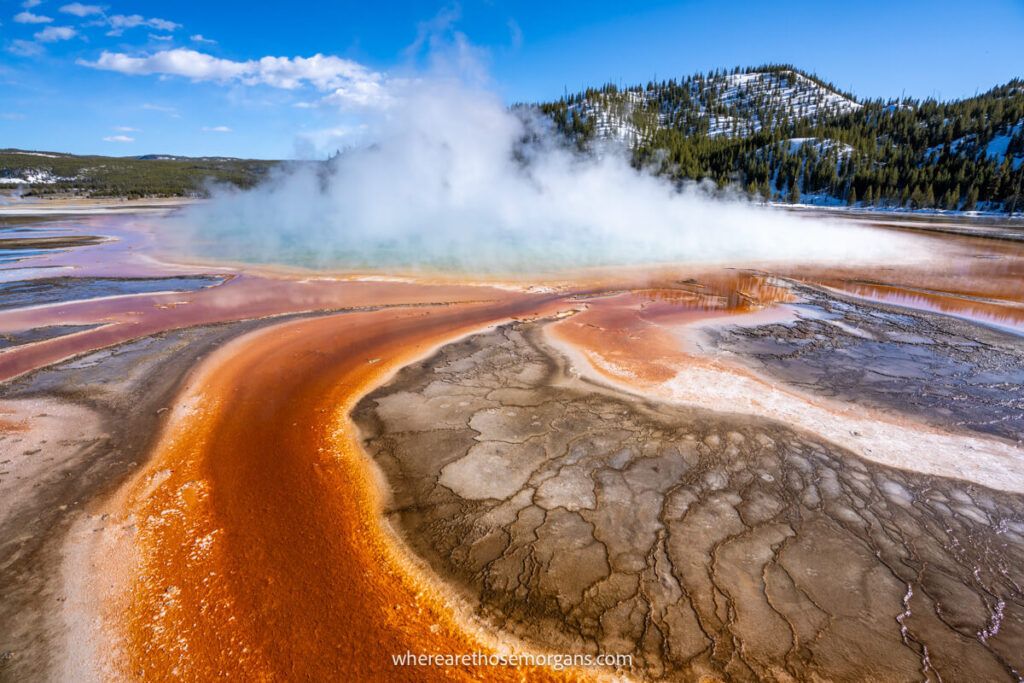
Midway Geyser Basin has the fewest thermal features of the three major basins in Yellowstone’s southwest corner, but it has one the most beautiful Yellowstone attractions, Grand Prismatic Spring.
One of the most famous photographs from Yellowstone National Park features a huge crystal clear deep blue pool encircled by yellow and orange rings.
This mesmerizing image is Grand Prismatic Spring from an elevated viewpoint along the Fairy Falls Trail. The trail is closed until the Saturday of Memorial Day weekend because it is a bear management area.
But there is more to see at Midway.
You will cross the Firehole River, which will be steaming on a cool or cold day, before seeing the mighty Excelsior Geyser first. On a cold day, Excelsior will be booming out steam like an old steam train.
Opal Pool and Turquoise Pool are both very attractive but if you can see Grand Prismatic Spring on a warm and clear day, you will be able to fully appreciate the beauty of this natural thermal wonderland.
Here are tips for visiting Midway Geyser Basin:
- Midway Geyser basin is located between Lower and Upper Geyser Basins
- Do not miss the viewpoint along Fairly Falls Trail, it is one of the best in the park (but it can only be accessed May to October)
- The boardwalk loop is very short at Midway Geyser Basin
- You will not be able to hike Fairy Falls Trail if you visit Yellowstone in April
25. Old Faithful In Upper Geyser Bain
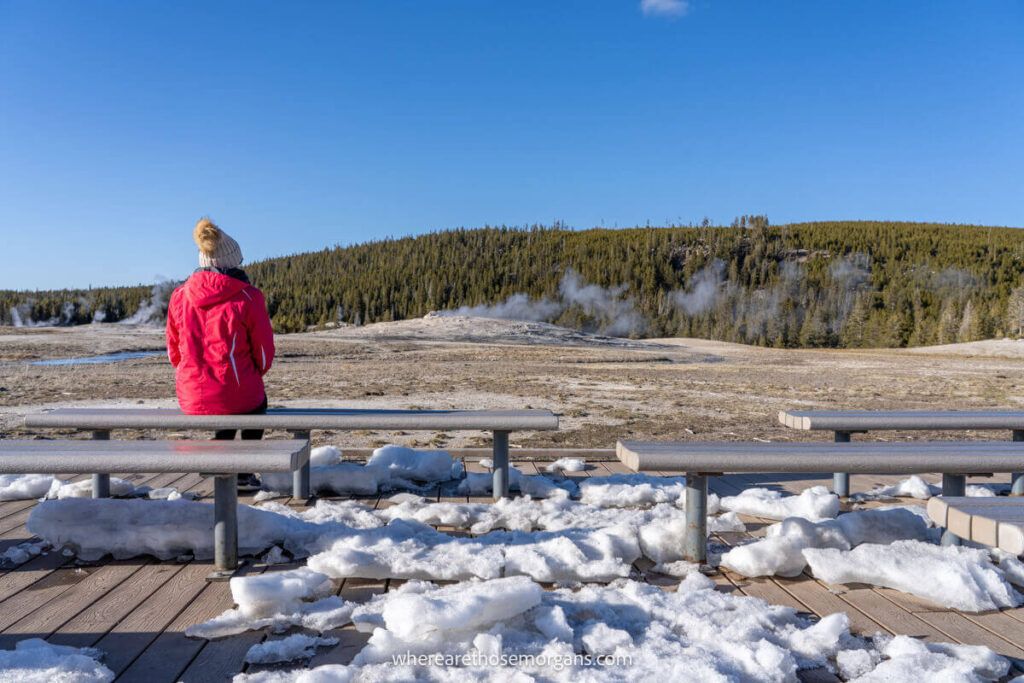
Located between West Thumb and Madison, Upper Geyser Basin is simply unmissable and has to be considered one of the very best things to do in Yellowstone National Park.
Old Faithful is the most famous geyser in the world and watching this geyser erupt is a rite of passage for first time visitors to Yellowstone.
There are there ways to see Old Faithful erupt:
- The main Old Faithful viewing area. This is the most accessible and popular area to watch with numerous benches for visitors directly in front of the geyser.
- Hike to Observation Point on Geyser Hill. Take this 1.6 mile roundtrip trail to experience a stunning view over the Upper Geyser Basin including Old Faithful.
- On the deck of the Old Faithful Inn. Grab some lunch and watch the famous geyser from the main deck of a gorgeous historic inn.
We recommend hiking to Observation Point to view an Old Faithful eruption because this is often a much quieter experience, but this trail is often closed in spring for bear activity.
This section of Yellowstone has the highest concentration of geysers of any region on the planet, which means Upper Geyser Basin is not just about Old Faithful, the star attraction.
Walk around the boardwalks among some of the best viewing spots in Yellowstone. This might be the most popular region in Yellowstone, but there is plenty of parking.
26. Geyser Hill In Upper Geyser Basin
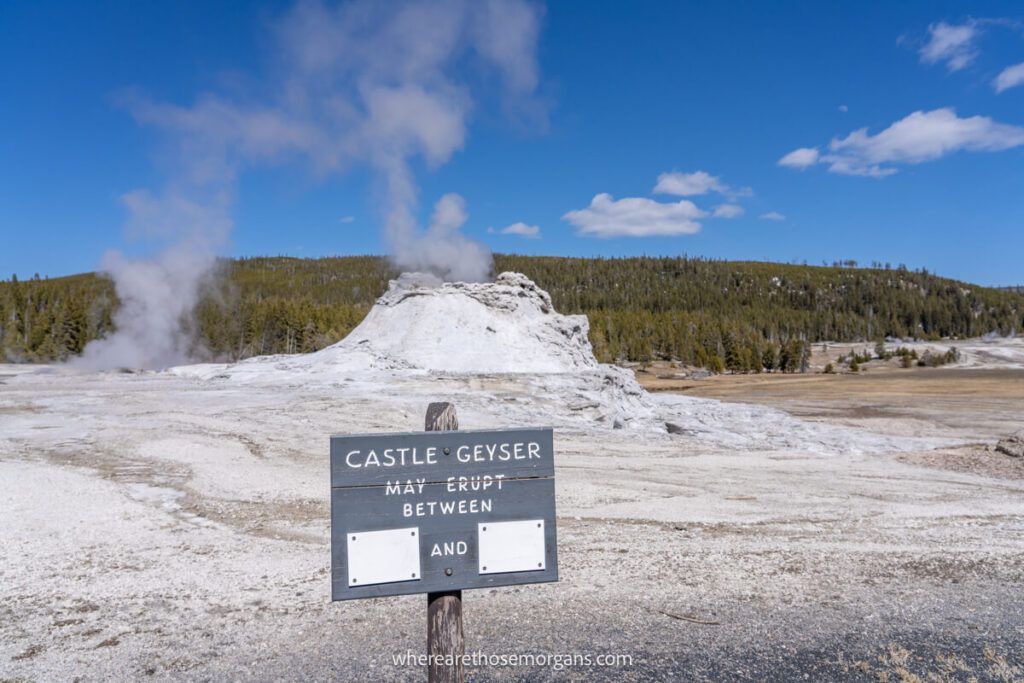
We strongly recommend you to spend at least 2 or 3 hours walking around the additional boardwalks of Upper Geyser Basin to see Castle Geyser, Riverside Geyser, Daisy Geyser and the Grand Geyser.
Exploring hidden geysers behind Old Faithful is among the best things to do on a visit to Wyoming.
Park rangers make predictions on eruption times for those geysers listed above and you will walk past endless colors, shapes and sizes when exploring the hydrothermal features in Upper Geyser Basin.
Another hidden gem attraction is Morning Glory Pool, which is almost like a miniature but more vibrant version of Grand Prismatic Spring. You will find this beautiful geyser at the bottom of Geyser Hill.
When you visit Old Faithful and Upper Geyser Basin you will inevitably find it jam packed full of tourists waiting in gleeful anticipation for the big event.
If that doesn’t sound like your cup of tea, take a short but steep hike up to Observation Point for amazing views over proceedings and hopefully thinner crowds.
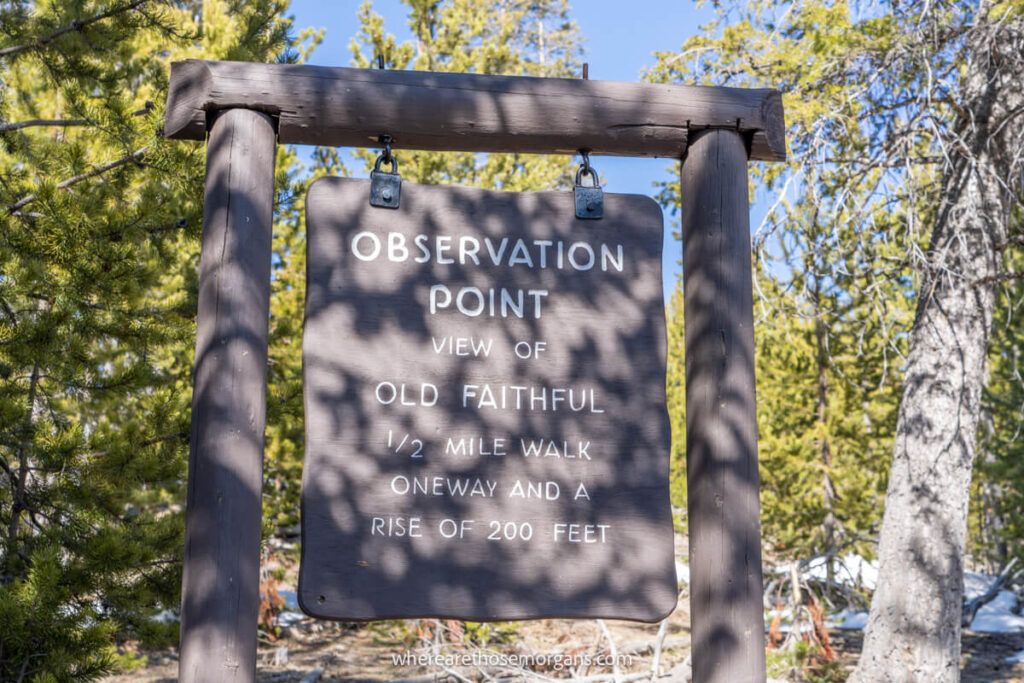
Here are the hiking statistics of Observation Point Trail in Geyser Hill:
- Distance: 1.6 miles round trip
- Difficulty: Moderately strenuous
- Type: 160 ft
- Elevation gain: 160ft
- Time: 1 hour
The Observation Point Trailhead is located behind and to the right of the Old Faithful Geyser. But this trail is often closed in spring for bear activity.
Observation Point is a steep trail but it’s absolutely worth it for views over Upper Geyser Basin. Sunset is the perfect time to watch the Old Faithful eruption from this overlook.
Travel Tip: There are six predictable geysers in Yellowstone and 5 of those are in Upper Geyser Basin. See Yellowstone geyser predictions here.
27. Black Sand Basin
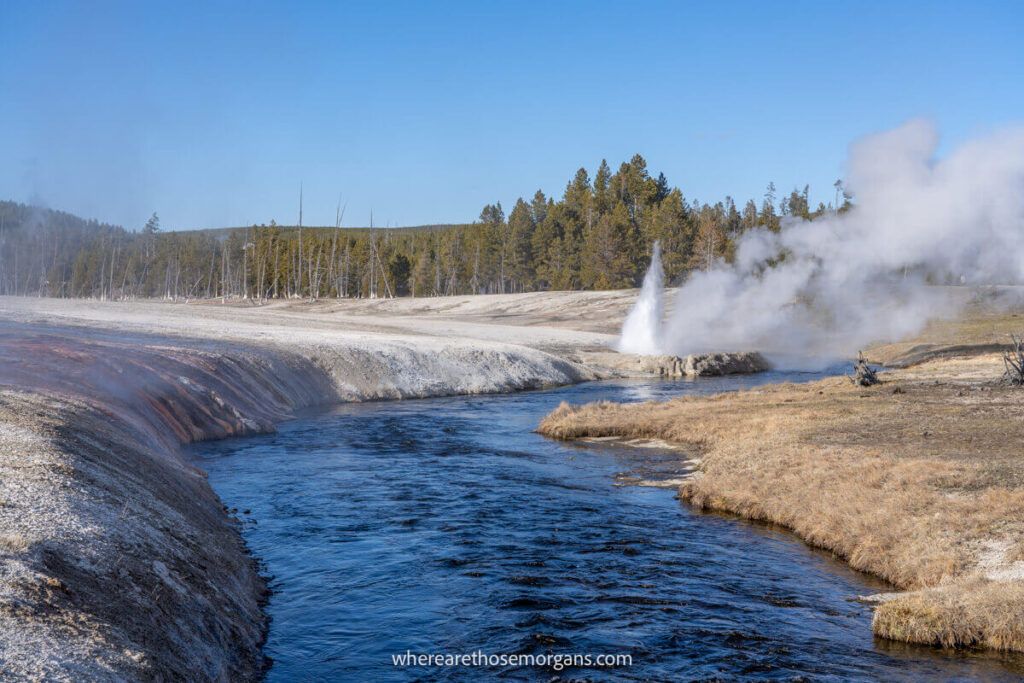
Black Sand Geyser is also part of Upper Geyser Basin and it has its own parking area. We think this is a fantastic lesser visited detour either before or after experiencing Old Faithful.
Emerald Pool and Rainbow Pool are some of the best spots in this very colorful basin named for its black sand (also known as obsidian, the natural form of glass).
Here are tips for visiting Black Sand Basin:
- The Black Sand Basin boardwalk trail is an out and back hike, not a loop
- Parking is limited in this section of Yellowstone
- You will be surprised by how visible the colors appear in this basin
- Black Sand Basin is located very close to Upper Geyser Basin entrance
28. Biscuit Basin
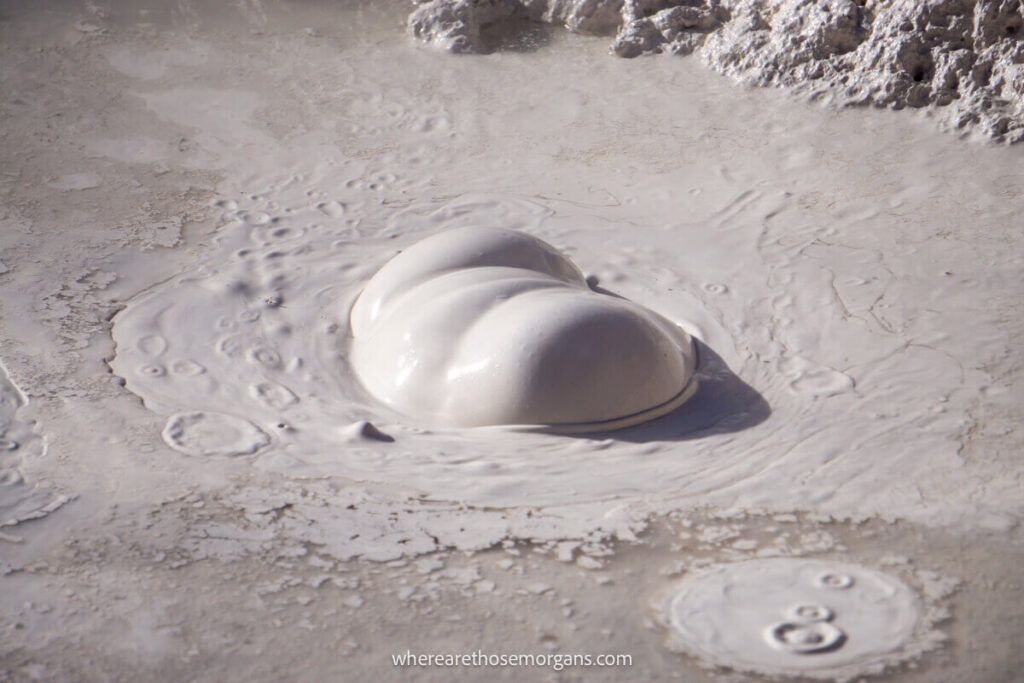
Biscuit Basin is considered to be another section of Upper Geyser Basin, but it has a separate parking area and many miss it in favor of Old Faithful.
This is another 0.7 mile roundtrip loop with notable features such as Jewel Geyser, Coral Geyser, Avoca Spring, Mustard Spring, Sapphire Pool and Black Opal Pool.
Here are tips for visiting Biscuit Basin:
- Biscuit Basin is located near Upper Geyser Basin
- There is ample parking in Biscuit Basin and it can be used as an overflow for Upper Geyser Basin if full
- You can follow a long trail from Biscuit Basin to Old Faithful, passing Morning Glory Pool
- This area can be quiet. When we visited in October, we has Biscuit Basin to ourselves
29. Old Faithful Inn
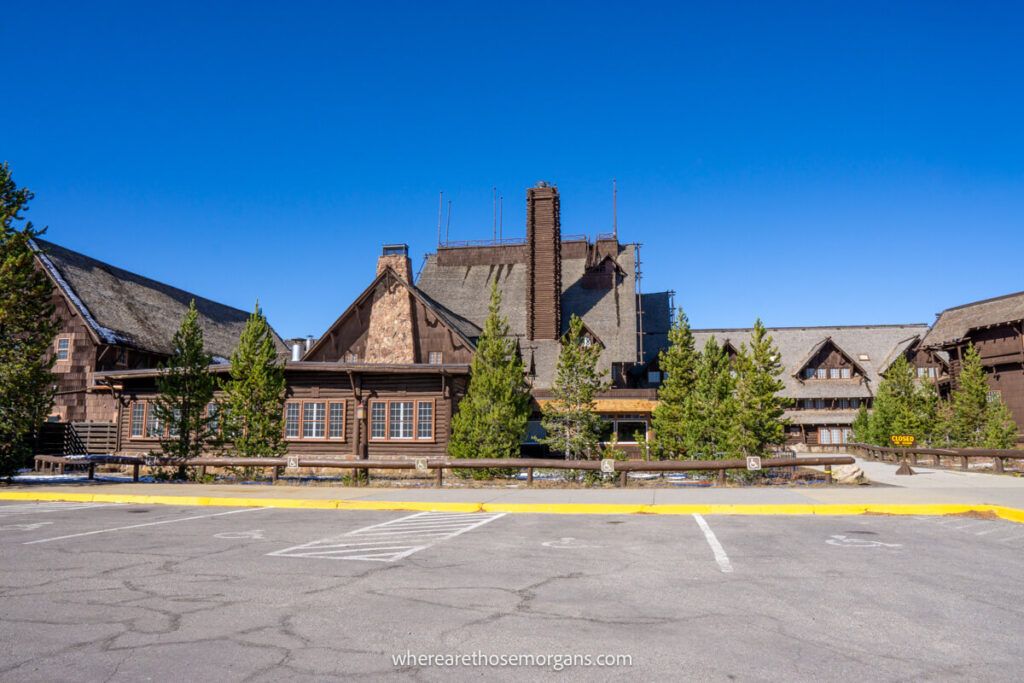
Even if you have no plans to stay in the Old Faithful Inn, we recommend you make a quick stop to see the gorgeous innate features of the 1904 enormous log cabin.
Now a National Historic Landmark, the Old Faithful Inn is the most popular lodging option in Yellowstone National Park.
You can book the Old Faithful Inn direct with Yellowstone Lodges or Hotels.com, but you will need to book well in advance because this stunning accommodation fills up extremely quickly.
Inside the lodge, you will find mammoth stone fireplace and a stunning hand-crafted clock. There are numerous accommodation options including beautiful suites, a deli, cafeteria and a dining room.
Need a hotel for your visit? Check out the where to stay when visiting Yellowstone.
30. Fairy Falls
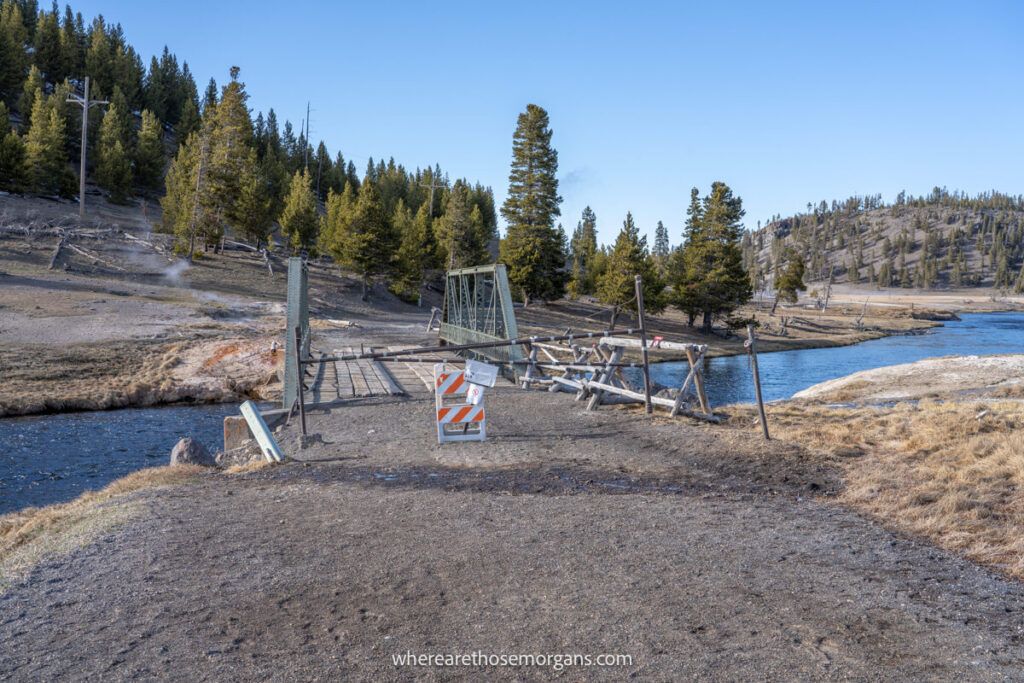
Fairy Falls is one of Yellowstone’s best spots to visit because a 197 ft plunging waterfall rushing from a cliff edge lands right in front of you as you stand at its base.
The bottom half of the waterfall has a cavernous hole in the cliff which looks very much like Batman’s secret lair in the super volcano.
But the Fairy Falls Trailhead provides access to the following trails:
- Grand Prismatic Overlook Trail
- Fairy Falls Trail
If you wish to hike to the Grand Prismatic Overlook Trail, this is an easy 1.2 mile gradual climb to a gorgeous view of Grand Prismatic Spring and the Midway Geyser Basin.
But if you want to hike to Fairy Falls Trail, this 5.0 mile easy hike leads to stunning Fairy Falls. Here are hiking statistics for the popular Fairy Falls hike:
- Distance: 5.0 miles roundtrip
- Difficulty: Easy
- Type: Out and back
- Elevation gain: 170 ft
- Time: 3-5 hours
There are two Fairy Falls trailheads with one beginning about a mile south of Midway Basin (recommended) and the other at the end of Fountain Flat Drive.
As the narrow waterfall hits rock, it fans out intricately into a triangle pyramid shape. You may see people dipping their feet into the base of the falls but this is at your own risk and not recommended.
31. Lone Star Geyser Trail
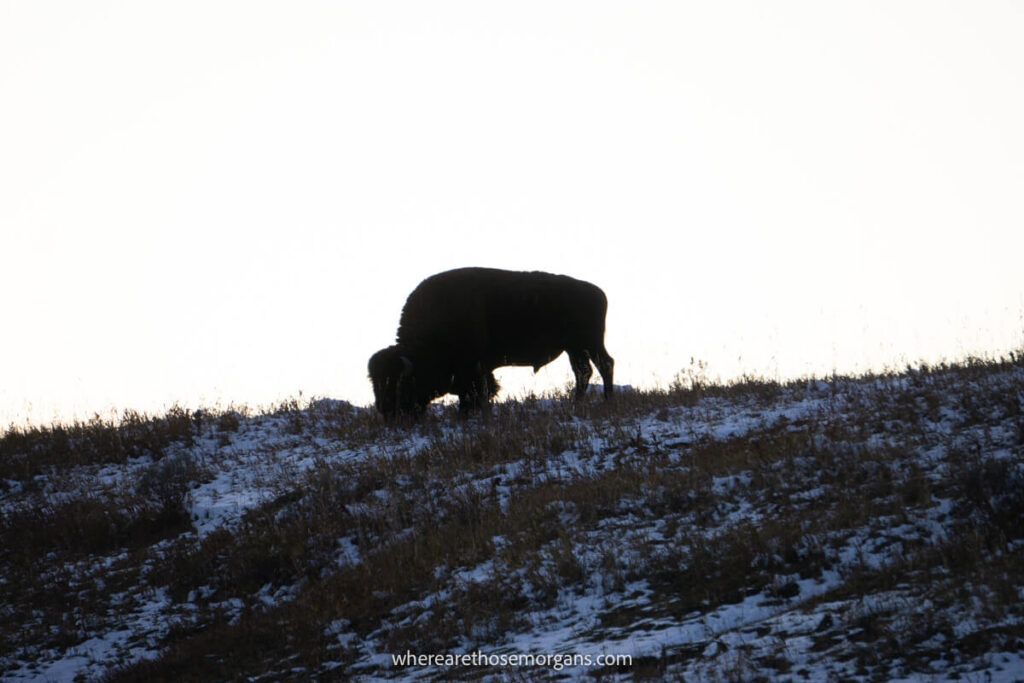
- Distance: 4.8 miles roundtrip
- Difficulty: Easy
- Type: Out and back
- Elevation gain: 120 ft
- Time: 2-3 hours
The Lone Star Geyser Trail is a very easy and flat paved trail along an old service road leading to the unique Lone Star Geyser.
This is an accessible and very leisurely walk through forested land, where people often see moose and a very worthwhile geyser eruption.
The only problem is Lone Star only erupts once every 3 hours. Typically, the geyser goes off sometime between 9:30am – 11:00am. Eruptions can reach 45 ft and last 30 minutes once it begins.
Here is what you need to known when hiking Lone Star Geyser:
- The Lone Star Geyser Trailhead is located between Old Faithful and West Thumb
- Bring bug spray because the trails follows the Firehole River
- Check with rangers or other hikers about when this geyser last erupted
- This is a nice easy family friendly hike
Hiking Tip: You can also use the 5.8 mile Howard Eaton Trail to reach Lone Star Geyser. This is a moderate hike through a burned hill and forest.
32. Mystic Falls Trail
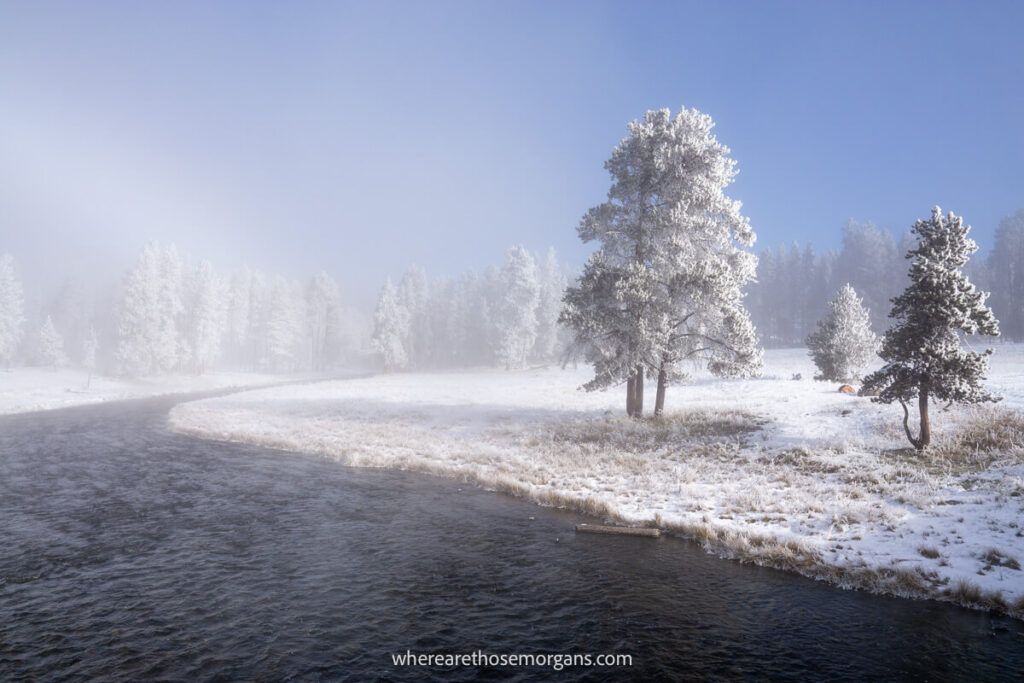
- Distance: 2.4 miles round trip
- Difficulty: Moderately strenuous
- Type: Out and back (with 1.5 mile loop option)
- Elevation gain: 600 ft
- Time: 2-3 hours
Another fantastic reason to visit relatively unknown Biscuit Basin is because you can hike a great trail to another waterfall, Mystic Falls. This Yellowstone sight is often missed by many visitors.
Mystic Falls is a 70 ft cascading waterfall plunging into Little Firehole River. We think this route is well worth a hike if you’re looking for a moderate 2-4 hour trail when visiting Yellowstone.
You can add on a steep climb for excellent views back across Upper Geyser Basin and include an additional 1.5 mile loop for a slightly longer but better hike.
Here is what you need to know when hiking Mystic Falls:
- Mystic Falls Trailhead is located at Biscuit Basin
- The waterfall and geyser basin are certainly worth the effort
- This is a family friendly hike for older children
- The Mystic Falls hike will be busy in summer so arrive early
33. Old Faithful Visitor Education Center
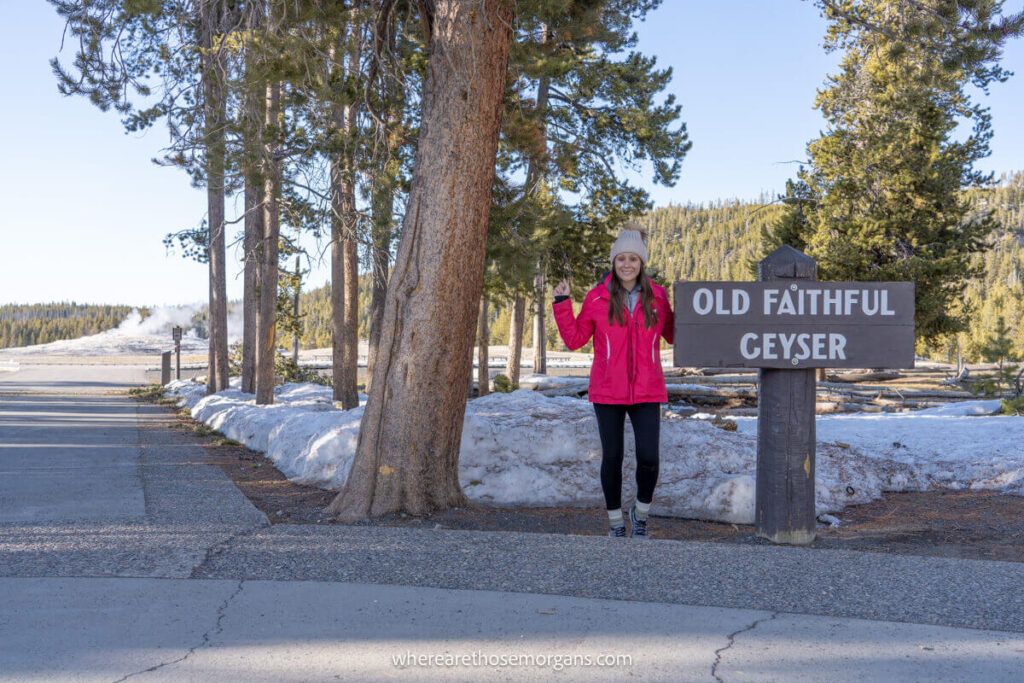
While not typically considered of the the best places to visit in Yellowstone, we think the Old Faithful Visitor Education Center is an important stop for anyone traveling to the park.
In this center, you will find informational exhibits about Yellowstone’s hydrothermal features and the ongoing research to understand the volcano beneath the ground you are currently standing.
If you are traveling with kids, don’t miss the Young Scientist Room with interactive exhibits. Adults will also enjoy ranger-led programs because who doesn’t love learning about amazing Yellowstone.
You will also find geyser predictions inside the education center so you can plan your trip around where to go in Yellowstone when the geysers are most active.
Best Things To Do At Yellowstone Lake
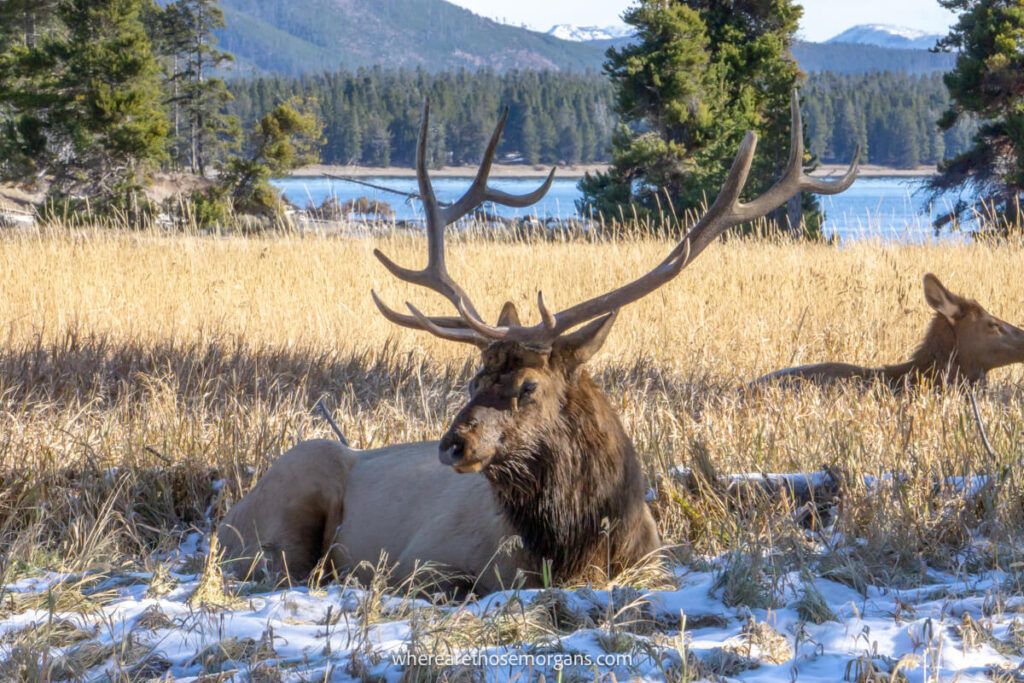
Last but not least, we will cover the best places to visit along Yellowstone Lake.
This lower region can be separated into West Thumb which sits on the western edge of Yellowstone Lake, while Fishing Village can be found on the northern edge of the lake.
In this instance, we are referring to Grant Village and West Thumb Geyser Basin of West Thumb, stretching around to Lake Village and Bridge Bay of Fishing Village.
34. Yellowstone Lake
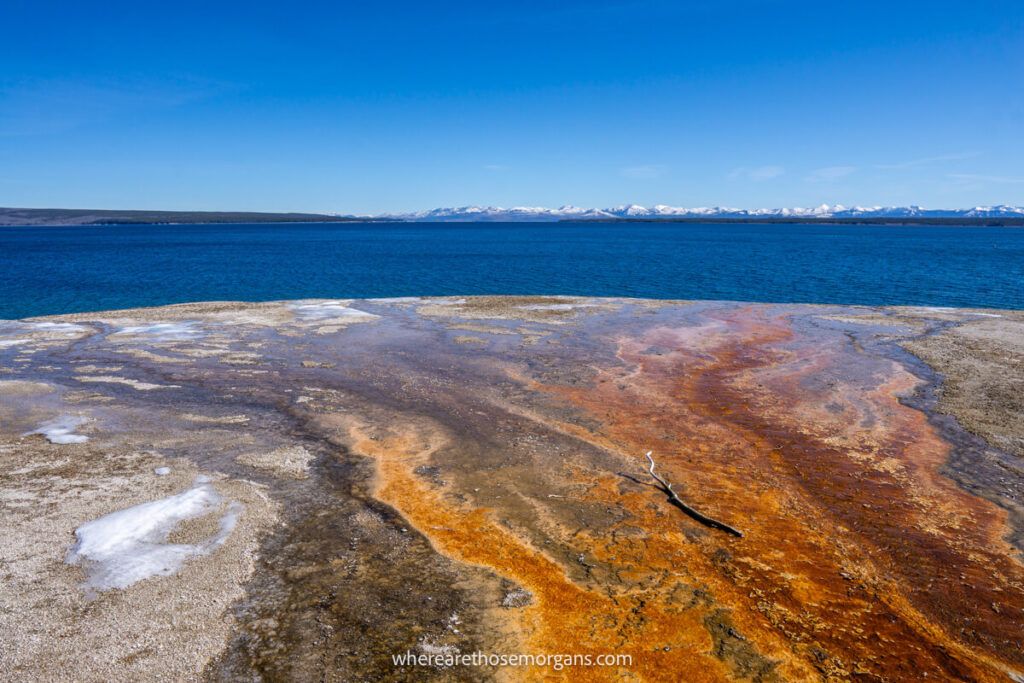
Lake Yellowstone is located near the east and south entrances of the park. This gorgeous lake sits at 7,733 feet (2,357 m) above sea level making it the highest elevation lake in North America.
When you visit the lake, you can make your way towards West Thumb (west) or Fishing Village (north) so depending on your Yellowstone bucket list, you have a few options.
We think the best part about this lower eastern region of Yellowstone is that this section is often much quieter in traffic and human terms so its a great place for spotting wildlife.
During our first visit, we followed a lone coyote that seemed to be in very high spirits in this area. We also saw a large herd of elk resting on snowy meadows.
But don’t be fooled by the picturesque lake because Yellowstone Lake averages a temperature of 41°F (5°C) year-round. The water is extremely cold and swimming is not recommended.
The estimated survival time is only 20 to 30 minutes in these cold temperates. We say this not to scare you, but to warm you of the hidden dangers in Yellowstone National Park.
35. West Thumb Geyser Basin
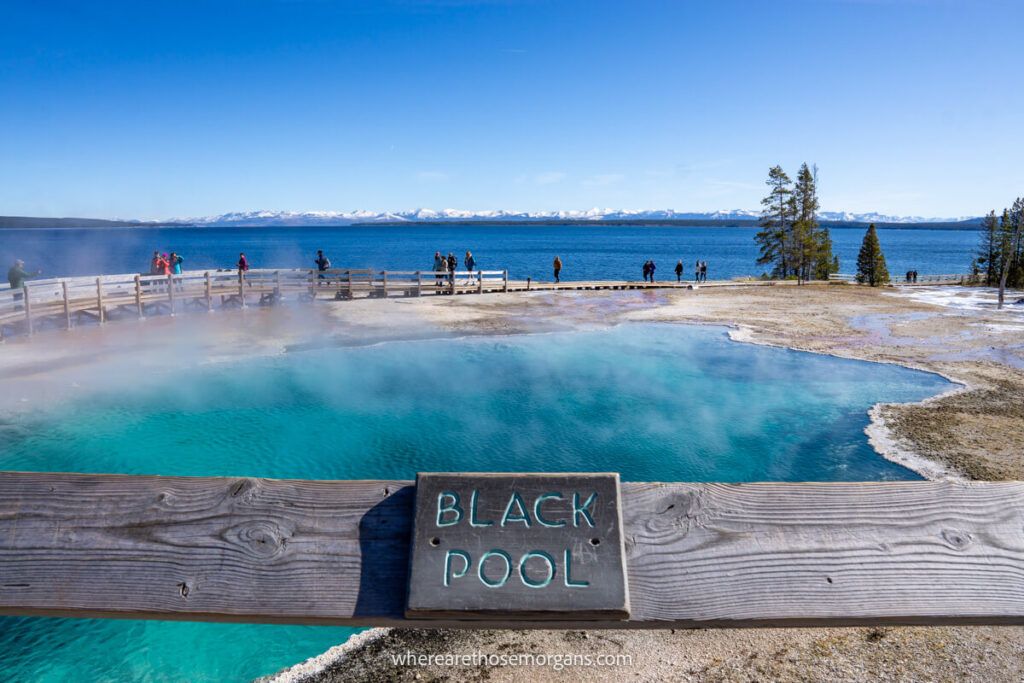
West Thumb is one of the least visited Geyser Basins in Yellowstone National Park, which is better for you because it will be quieter and more enjoyable.
There are no major hot springs or geysers here, but there are a variety of gorgeous pools and interesting hot springs, such as Fishing Cone, Abyss Pool, Black Pool and Lakeshore Geyser.
What makes West Thumb Geyser Basin unique is its location right on the edge of Yellowstone Lake, with many of its features inside the shallow water.
Here are tips for visiting West Thumb Geyser Basin:
- West Thumb Geyser Basin is located very close to the south entrance (towards Grand Teton)
- The boardwalk loop trail is easy to follow and it can quiet
- You can hike to Yellowstone Lake Overlook for arial views of the alpine lake and the distant Absaroka Mountains
- The stunning mountain views over the lake are worth visiting alone
36. Gull Point Drive
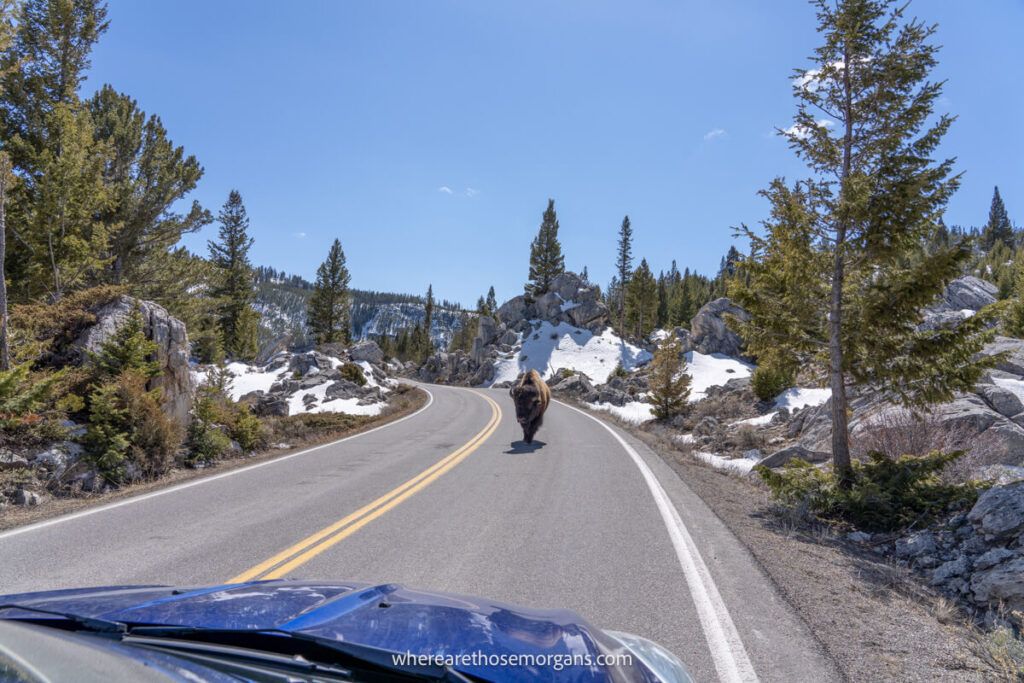
One of the lesser known things to see in Yellowstone is the scenic route down Gull Point Drive.
We like this 2.0 mile two-way road that spurs of the Grand Loop Road near Yellowstone Lake because it features a large picnic area in shaded trees.
This is a great place to park and enjoy the views because you take an easy hike down to the lakeshore via a sandbar which juts out into the lake.
Travel Tip: This drive may be closed in spring due to high water levels.
37. Mary Bay
Yellowstone Lake is a unique place to visit in Yellowstone because this is the only place in the park where underwater geysers can be found (remember, no swimming).
We added Mary Bay to our best things to do in Yellowstone National Park list because this is where the hottest temperature in the lake was recoded at 252°F (122°C).
Many of the rocks from Mary Bay are currently being analyzed, but the hollow chimneys of silica that sit beneath the water are old features of now dormant geysers.
38. Natural Bridge
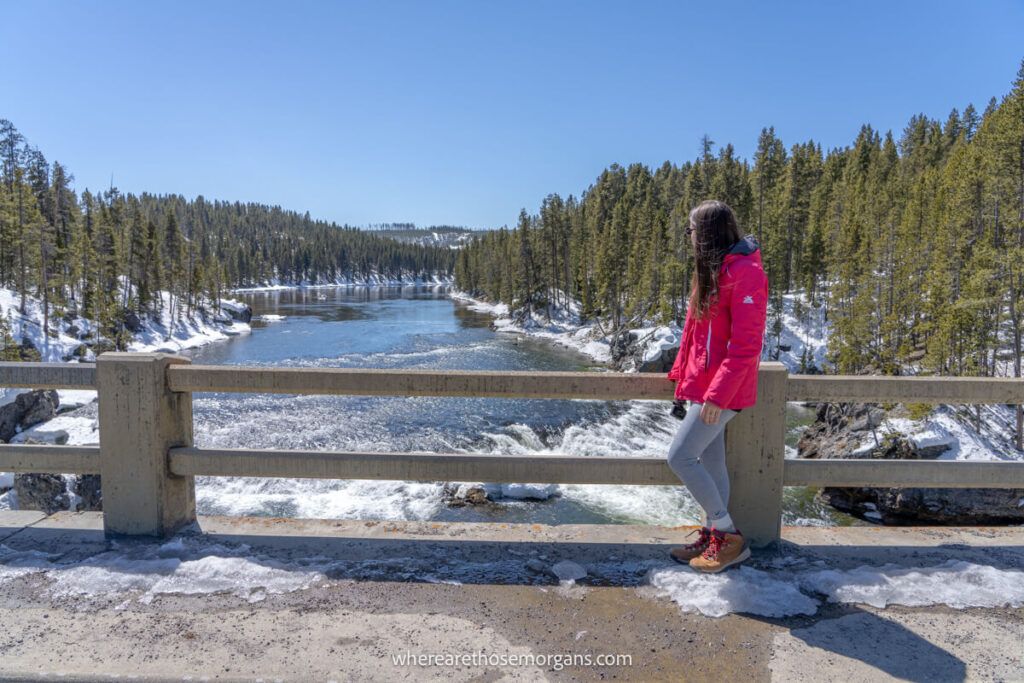
- Distance: 2.5 miles roundtrip
- Difficulty: Easy
- Type: Out and back
- Elevation gain: 200 ft
- Time: 1-2 hours
Located in the Bridge Bay Marina parking lot near the campground, you will find the trailhead for the Natural Bridge hike.
The trails leads through a forest to a 51 ft natural bridge made from rhyolite rock. This is an extremely fragile resource so please do not hiker or bike on top of the natural bridge.
Keep in mind the Natural Bridge Trail is closed until early summer because bears frequently use this area to feed on spawning trout.
39. Avalanche Peak
- Distance: 4.2 miles roundtrip
- Difficulty: Strenuous
- Type: Out and back
- Elevation gain: 2,050 ft
- Time: 3-4 hours
Avalanche Peak is a steep hike in Yellowstone, but its rewards are worth the climb. However, something to consider is the high elevation along this trail reaching over 10,500 ft at the summit.
There are very few mountain peaks you can actually summit in Yellowstone and this is one of the easier, quicker peaks you can reach on a day hike.
Hikers who reach the summit of Avalanche Peak will see some of the best views in Yellowstone’s tallest and most remote alpine peaks.
Here is what you need to know when hiking Avalanche Peak:
- The Avalanche Peak Trailhead is located on Yellowstone east entrance road
- This trail is often snow covered until mid-July due to its high elevation
- Hikers will experience a very steep climb, but its worth it for the views
Hiking Tip: Grizzly bears can be found on Avalanche Peak looking for whitebark pine nuts during the fall season so hiking this trail in September or October is not recommended.
40. Lake Yellowstone Hotel
Another historic hotel in Yellowstone, this hotels offers something completely different compared to the looming wooden structure of the Old Faithful Inn.
The Lake Yellowstone Hotel under went extensive interior renovations in 2014 in order to restore it’s colonial heritage. This bright yellow building with large white columns is hard to miss.
Open mid-May to early October, the Lake Yellowstone Hotel showcases stunning lake views with a dining room, deli, bar and numerous public spaces.
You can book gorgeous rooms directly with Yellowstone Lodges or Hotels.com.
Yellowstone Off The Beaten Path
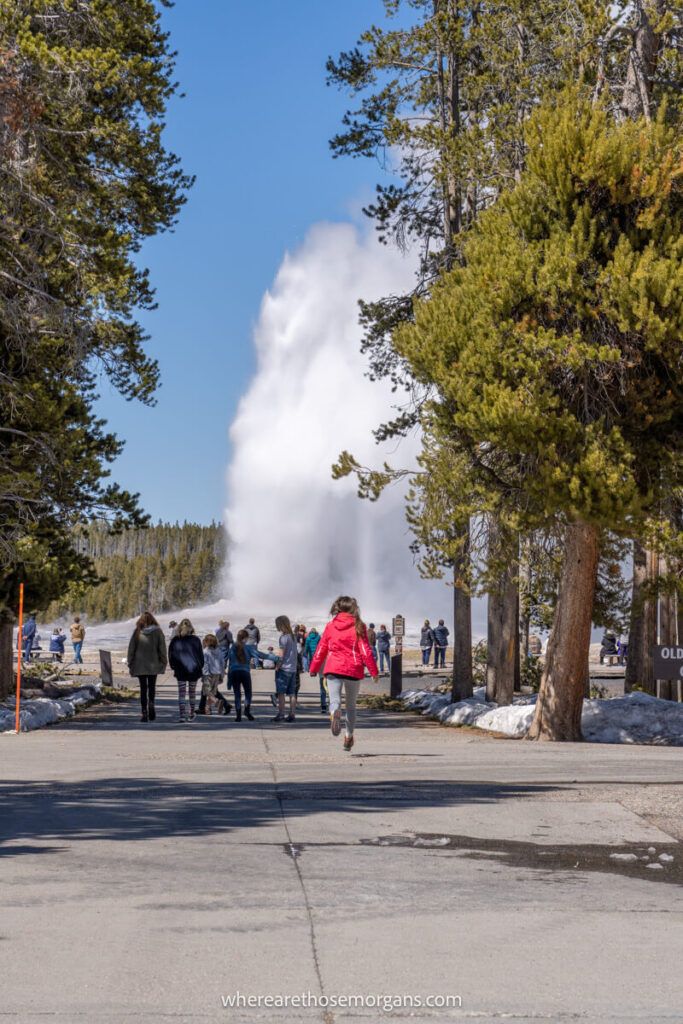
No matter when you visit Yellowstone, there are going to be extremely busy sections in the park. We found the key to having the best Yellowstone experience is going off the beaten tourist path.
Here are a two additional places to visit in Yellowstone where we had great wildlife experiences:
Yellowstone East Entrance
Lamar and Hayden Valleys are so well known that sometimes they become too busy with humans, which causes certain animals to stay clear.
We think Yellowstone east entrance (between Cody and Yellowstone Lake) is one of the best hidden gem wildlife spotting areas in Yellowstone National Park.
Elk are plentiful in the lower lying areas near Cody, and grizzly bears make regular appearances closer to the mountains. Bighorn sheep, pronghorn and moose can also be seen here.
Here are tips for visiting the Yellowstone East Entrance:
- The Yellowstone East Entrance is located between Cody, WY and Yellowstone Lake
- Park on the side of the road or a pull out and let animals come to you
- Avalanche Peak is located along this stretch of road and it traverses Yellowstone’s backcountry
Firehole River South Of Grand Prismatic Spring Area
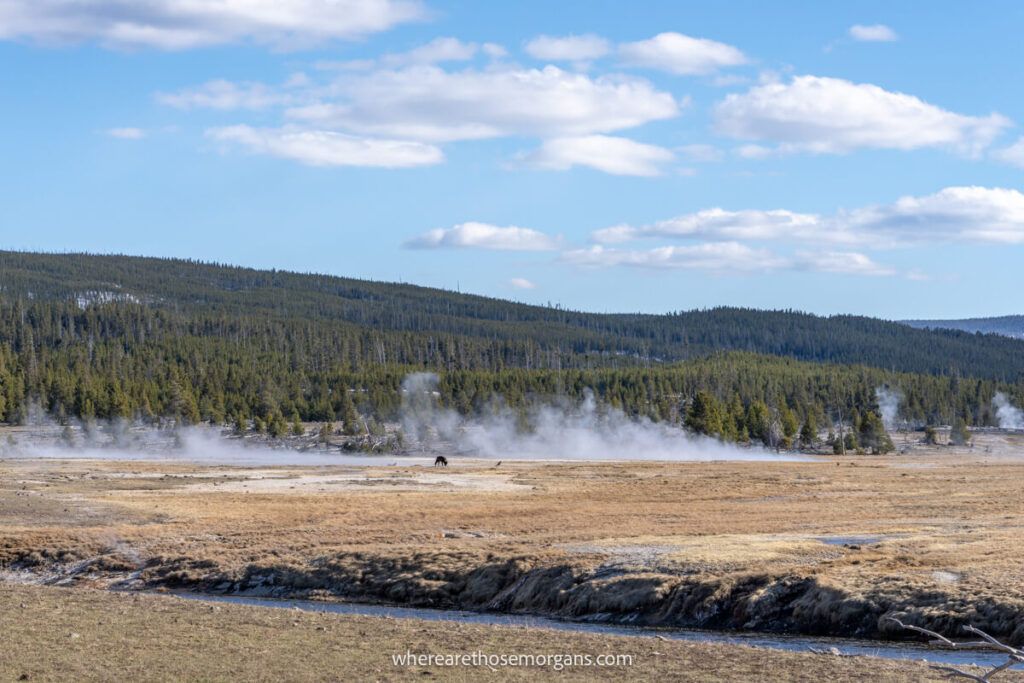
You will see wildlife all over Yellowstone, these suggested places are only recommendations but there’s no guarantee you will have the same luck.
We have included the sweeping meadows south of Grand Prismatic Spring in this list because on our last visit in Spring 2021, we watched a lone wolf eat a carcass and become silhouetted by geyser steam when wind blew in the right direction.
As you can imagine, that was a very dramatic and almost cinematic sight for us. You might get something similar but it could be somewhere else in the park.
Wolf sightings has been common in this same meadow in the days leading up to our visit so we visited here on a rangers recommendation.
Here are tips for spotting wildlife in the Midway Buff:
- The large meadows are located directly next to Grand Prismatic Spring
- There is a very large pull off area overlooking the meadows
- Fairy Falls Trailhead begins nearby, but is closed until summer for bear activity
Travel Tip: If you are interested in seeing wildlife, stop into one of the Visitor Centers. The park rangers are a great resource and can often tell you where recent wildlife activity has been.
Yellowstone Vacation Tips
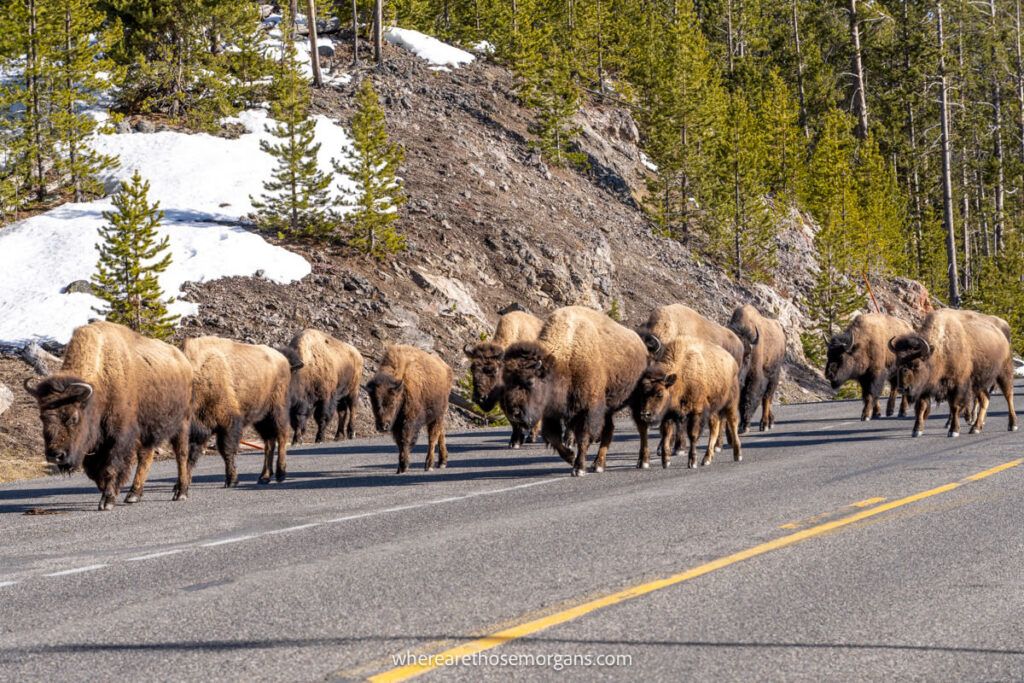
Let’s take a brief look at some important considerations we recommend having visited Yellowstone on two separate occasions:
- Allow at least 4 full days in Yellowstone if this is your first visit
- Ideally you would spend 1 night in 2 or 3 different areas to reduce driving
- Always check road and park entrance closures before booking and then check again when visiting
- Start early each morning to beat the crowds and visit your top Yellowstone experiences first
- Animals are the most active at dawn and dusk so it pays to be the early bird
- Yellowstone is a 4 season wonderland, but think carefully about which season you want to visit because there are pros and cons to each one
- Weather is unpredictable in spring and fall, but animals are the most active in these seasons
- Summer is extremely crowded at Yellowstone attractions, but all hiking trails are open
- Geysers, pools and hot springs are best seen in summer months when the air is warmer
- Winter is a great season to visit the park for skiers and snowshoers
- Some of the very best USA road trips include Yellowstone and Grand Teton
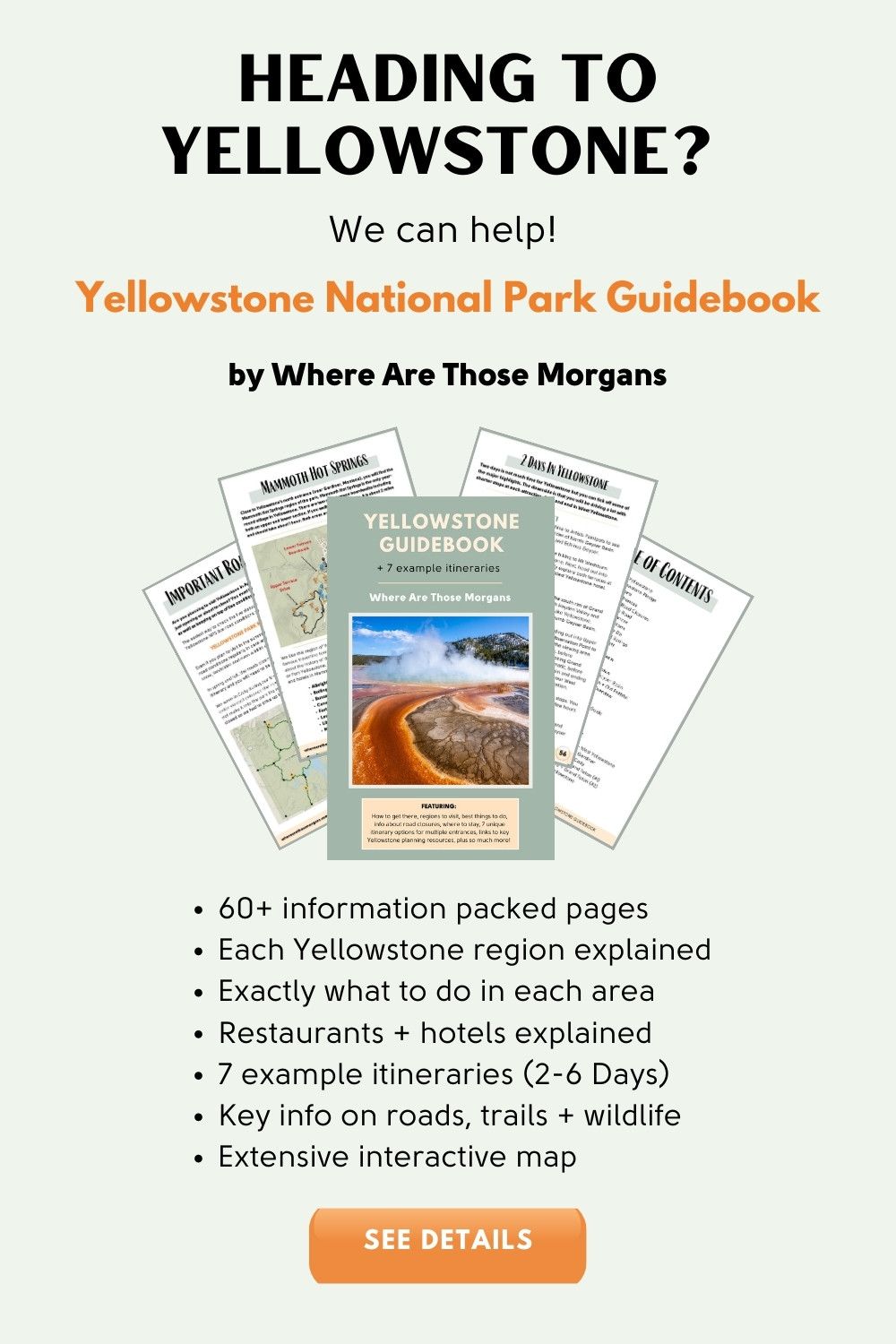
Best Things To Do In Yellowstone FAQ’s
Let’s take a look at some of the most frequently asked questions about places to see in Yellowstone:
In Yellowstone, you can see extraordinary geothermal features, steaming geysers, boiling hot springs, bubbling mud pots, stunning meadows and spectacular canyons. But you will also find stunning waterfalls, numerous hiking trails and some of the best wildlife spotting the United States has to offer.
We broke Yellowstone National Park into 6 main regions to help you plan your visit including Mammoth, Tower, Canyon, Norris, Old Faithful and Yellowstone Lake. Plan to visit each of 6 these regions and visit the main highlights if you are short on time.
Yellowstone is a very large national park with 5 main entrances so its best to stay the night in a few different locations to minimize your drive time and make the most of your trip. Use our best hotels for Yellowstone guide to plan your itinerary.
Our Popular Yellowstone Guides
- Itinerary – How to spend 4 amazing days in Yellowstone
- Logistics – 10 best airports near Yellowstone National Park
- Hotels – Best places to stay inside and near Yellowstone
- Spring – 10 important things to know about Yellowstone in April
- Fall – 10 key things to know about Yellowstone in October
- Grand Teton – Best things to do in Grand Teton with itinerary
- South Dakota – Mount Rushmore to Yellowstone road trip guide
- Utah – How to plan a Salt Lake City to Yellowstone road trip
More Things To Do Guides
- Badlands – 32 fun things to do in Badlands National Park
- Capitol Reef – 22 amazing things to do in Capitol Reef
- Las Vegas – 40 thrilling things to do in Las Vegas
- Grand Canyon – Best things to do on Grand Canyon South Rim
- New York City – 50 cheap and fun things to do in NYC
- San Francisco – 40 cool things to do in San Francisco
- Sedona – 20 best things to do in Sedona, Arizona
- Valley of Fire – 15 unique things to do in Valley of Fire
Want more Wyoming content? Head over to our Wyoming Travel Guides to explore Yellowstone National Park, Grand Teton National Park and beyond.
We hope our detailed guide about what to see in Yellowstone National Park helps with planning your Wyoming trip!
Please let us know if you have any questions about places to visit in Yellowstone or top Yellowstone sights in the comments below.
Happy Travels,
Mark and Kristen
Enjoy This Yellowstone National Park Guide? Pin It For Your Visit!
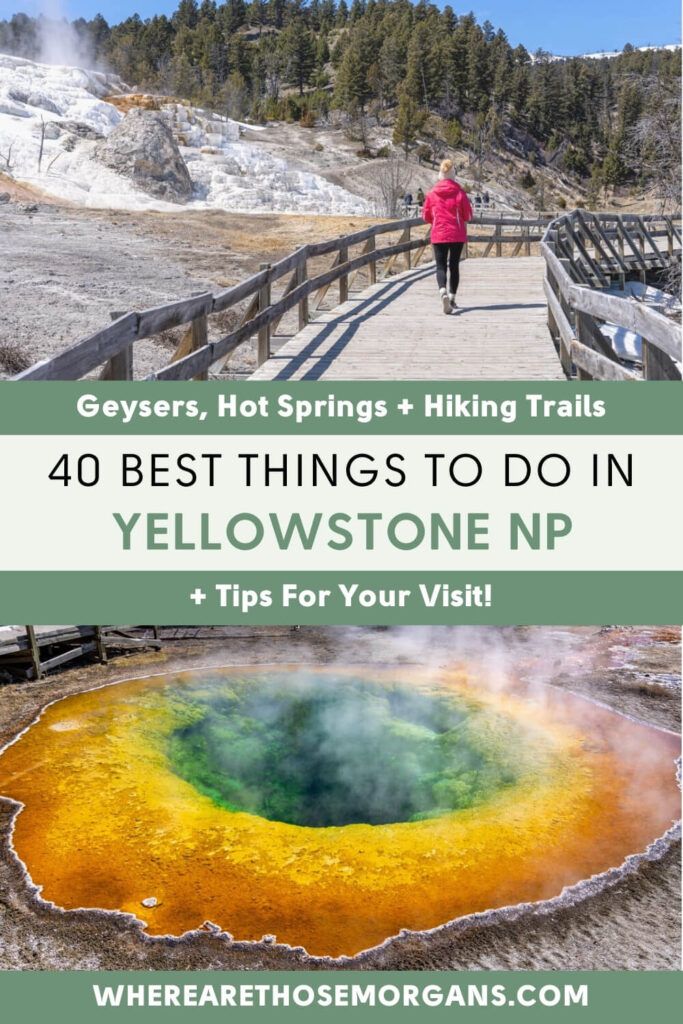
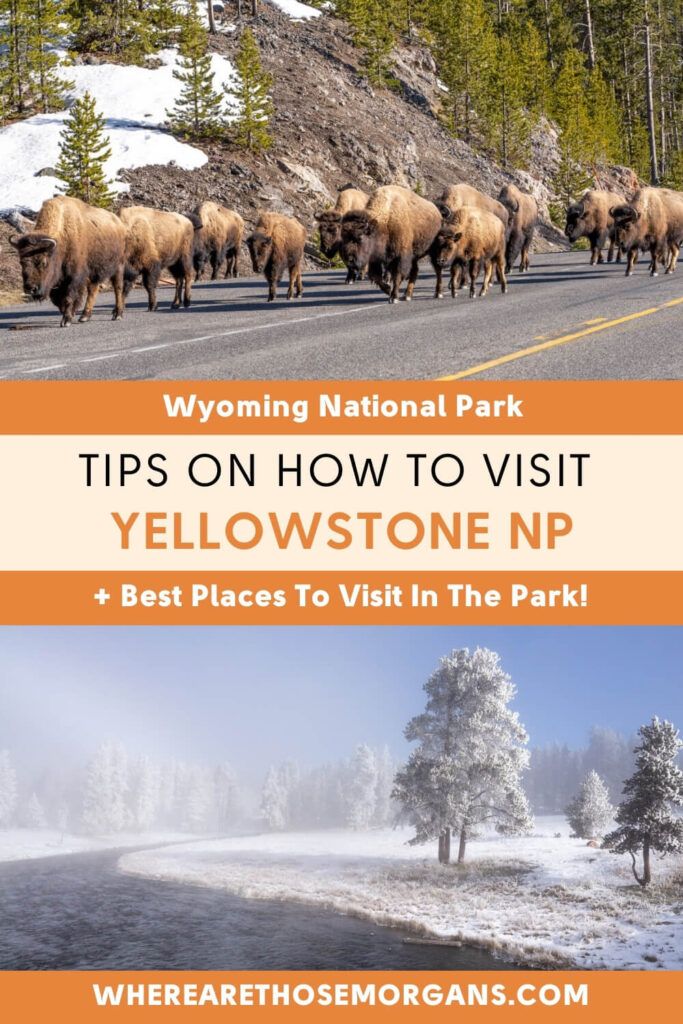
Note: This article contains affiliate links. When you make a purchase using one of these affiliate links, we may earn a small commission at no extra cost to you.
All Rights Reserved © Where Are Those Morgans, LLC. Republishing this article and/or any of its contents (text, photography, maps, graphics, etc.) in whole or in part is strictly prohibited.
Mark and Kristen Morgan are travel, hiking and photography experts. Over the last 6 years traveling full time, they have explored more than 40 countries and 30 US states.
Where Are Those Morgans has been featured in USA Today, Gestalten, Get Your Guide, CityPASS and Condé Nast Traveler along with various other publications. Read more about us.

